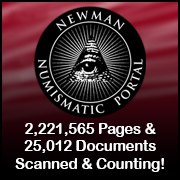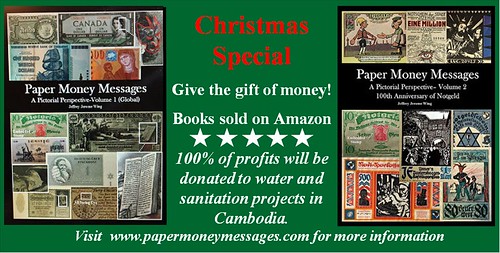
About UsThe Numismatic Bibliomania Society is a non-profit association devoted to the study and enjoyment of numismatic literature. For more information please see our web site at coinbooks.org SubscriptionsThose wishing to become new E-Sylum subscribers (or wishing to Unsubscribe) can go to the following web page link MembershipThere is a membership application available on the web site Membership Application To join, print the application and return it with your check to the address printed on the application. Print/Digital membership is $40 to addresses in the U.S., and $60 elsewhere. A digital-only membership is available for $25. For those without web access, write to: Terry White, Treasurer AsylumFor Asylum mailing address changes and other membership questions, contact Terry at this email address: terrywhite5475@yahoo.com SubmissionsTo submit items for publication in The E-Sylum, write to the Editor at this address: whomren@gmail.com BUY THE BOOK BEFORE THE COINSale Calendar |
- WAYNE'S WORDS: THE E-SYLUM DECEMBER 9, 2018
- NEW BOOK: MONNAIES ROYALES FRANÇAISES, 40TH EDITION
- NEW BOOK: ECUADORIAN COINS
- NEW BOOK: THE IBNS INTRODUCTION TO BANKNOTES
- BOOK REVIEW: SO-CALLED DOLLARS PACIFIC COAST EXPOS
- LEVICK, MEHL, AND BOWERS
- WALTER DOUGLAS ALLAN (1933-2017)
- IDAHO TRADE TOKEN NEWSLETTER ON NEWMAN PORTAL
- ON BLOGS IN THE SOCIAL MEDIA AGE
- READERS REMEMBER RICHARD MARGOLIS
- NOTES FROM E-SYLUM READERS: DECEMBER 9, 2018
- QUERY: EXPORT-IMPORT BANK CERTIFICATE
- VOCABULARY TERMS: BELL METAL, BEESWAX
- GEORGE AYER LEAVITT (1822-1888)
- CLASSICAL NUMISMATIC GROUP TRITON XXII SALE
- HERITAGE 2018 NYINC WORLD COINS SALE SELECTIONS
- NUMISMATIC NUGGETS: DECEMBER 9, 2018
- 11TH CENTURY CAESAREA GOLD COIN HOARD
- THE 1868/6 AUSTRALIAN OVERDATE SOVEREIGN
- MAN CLEARED OVER IMPORTING SCRAP EUROS
- NEW RESEARCH ON THE SAUDI ARABIA GOLD DISCS
- THE CAMERON HOUSE THEORY
- LAND LIMITATION, HIT HIM AGAIN COUNTERSTAMPS
- DECEMBER 2018 MEDAL SELECTIONS FROM NUMISMAGRAM
- ENDANGERED SPECIES BANKNOTE DESIGN CONCEPTS
- LOOSE CHANGE: DECEMBER 9, 2018
Click here to access the complete archive a
Click here to unsubscribe (scroll down)
To comment or submit articles, reply to whomren@gmail.com
Content presented in The E-Sylum is not necessarily researched or independently fact-checked, and views expressed do not necessarily represent those of the Numismatic Bibliomania Society.
WAYNE'S WORDS: THE E-SYLUM DECEMBER 9, 2018
 New subscribers this week include: Mark Huey, JP Koning, Eric van der Linden, and Edward Luers. Welcome aboard! We now have 5,816 subscribers.
New subscribers this week include: Mark Huey, JP Koning, Eric van der Linden, and Edward Luers. Welcome aboard! We now have 5,816 subscribers.
Thank you for reading The E-Sylum. If you enjoy it, please send me the email addresses of friends you think may enjoy it as well and I'll send them a subscription (but let me know if they are located in the European Union). Contact me at whomren@gmail.com anytime regarding your subscription, or questions, comments or suggestions about our content.
This week we open with three new books and one review. Other topics this week include Idaho trade tokens, dealer Richard Margolis, bell metal, the Caesarea gold hoard, scrap Euro coins, the Saudi Arabia gold discs, and the "Hit Him Again" counterstamp.
To learn more about French Royal coins, J.N.T. Levick, blogs in the social media age, beeswax, the Athenian dekadrachms, the Gabon Rhinoceros token, World War Zero, Pax in Nummis, and gambling, dancing & kindred vices, read on. Have a great week, everyone!
Wayne Homren
Editor, The E-Sylum
NEW BOOK: MONNAIES ROYALES FRANÇAISES, 40TH EDITION
A new edition of the Gadoury book on the coins of the Kings of France has been published. Here's the press release. -Editor
 The 40th anniversary edition of Monnaies Royales Françaises, 1610-1792, by Francesco Pastrone, a standard reference book on the coins of the Kings of France
beginning with Louis XIII (1610) and ending at the French Revolution, has been released and is now available to collectors in North America with delivery in the middle of January.
Its updated format has a tabular presentation of French Royal coins arranged by reign. They then go by denomination from the lowest value to the highest, starting with bronze
coinage, then silver, and finally gold, with rarity scales and entirely revised euro prices in three conditions.
The 40th anniversary edition of Monnaies Royales Françaises, 1610-1792, by Francesco Pastrone, a standard reference book on the coins of the Kings of France
beginning with Louis XIII (1610) and ending at the French Revolution, has been released and is now available to collectors in North America with delivery in the middle of January.
Its updated format has a tabular presentation of French Royal coins arranged by reign. They then go by denomination from the lowest value to the highest, starting with bronze
coinage, then silver, and finally gold, with rarity scales and entirely revised euro prices in three conditions.
Numerous new coins have been added, along with nearly 300 new photos. Prices are entirely revised. The 376 page, 5.9 x 8¼ inch, French language book is hard bound and costs $49.50. It is published by Editions Gadoury of Monaco.
This is the fifth edition of a book that is known colloquially as “Gadoury White.” The fourth edition was published in 2012, making this six year gap the shortest between editions. The author explains in the Introduction that the trend in prices during the last five years, especially for coins in exceptional quality or of great rarity, reached levels that were previously unthinkable. At the same time, the market has been quiet for lower quality coins, so prices have been cut in B (Beau or Very Good), TB (Trés Beau or Fine) and sometimes even in TT B (Trés Trés Beau or Very Fine). For the first time, there are some prices listed with MS-type grade designations. The new book is a more accurate reflection of the market.
Editorial modifications include several dozen newly confirmed or discovered coins, the reclassification of some badly cataloged ones, especially from the reign of Louis XIII, and the inclusion of several unpublished coins of Louis XIV.
The book may be ordered from the Coin & Currency Institute, P.O. Box 399, Williston, Vermont 05495. $5.75 should be added to each order for shipping and handling in the U.S.A. Canadian orders will be billed actual postage cost. Major credit cards are accepted. Call toll-free 1-800-421-1866. Fax (802) 536-4787. E-mail: mail@coin-currency.com.
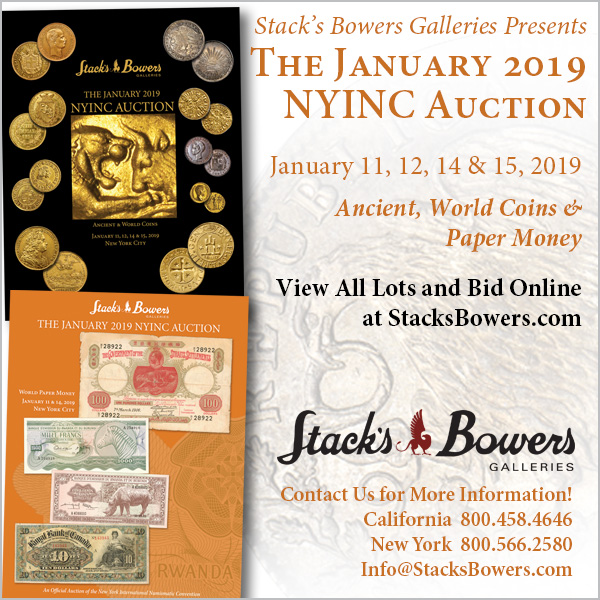
NEW BOOK: ECUADORIAN COINS
Dale Seppa forwarded this information about his new book on Ecuadorian coins. Thanks and congratulations. -Editor
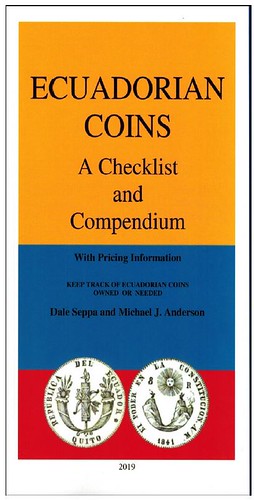 ECUADORIAN COINS
ECUADORIAN COINS
A Checklist and Compendium
LCCN 2018908633
By Dale Seppa and Michael J. Anderson.
Heavy card covers 4.3/4”(120 mm) by 8.1/2”(215 mm), 132 pages. Over six hundred items are listed and uniquely numbered. Many items are priced based on recent auction results. Illustrated with many high quality drawings. Scheduled for release January 1st.
PRE-COLUMBIAN MONEY, COLONIAL COINAGE, WARS OF INDEPENDENCE, REPUBLICAN PROTO-COINAGE, PRE- DECIMAL COINAGE, DECIMAL COINAGE, PRE-DECIMAL GOLD COINAGE, DECIMAL GOLD COINAGE, EARLY PATTERNS & UNUSUAL, DECIMAL PATTERNS & UNUSUAL, SETS, SILVER SPECIAL ISSUES, GOLD SPECIAL ISSUES, TOKENS & SCRIP OF THE GALAPAGOS and COUNTERMARKS OF THE GALAPAGOS
Pre-publication single copy orders are $20.00 postpaid for delivery in the United States.. Foreign orders must add $15.00 for postage. Registration for foreign orders is an additional $15.00 if desired. Price will be $30 after January 1, 2019
Two or more copies 20% discount; five or more copies 30% discount; ten or more copies 40% discount; twenty or more copies 50% discount; fifty or more copies 60% discount.
All orders are postpaid to addresses in the United States. If desired, insurance is extra. (Actually, I have never lost a book package in the U.S.)
PRE-PUBLICATION SPECIAL
Twenty-five (25) copies delivered to the U.S or Ecuador by the United States Postal Service for $200. Ecuadorian orders will go by INTERNATIONAL PRIORITY MAIL. They are sent by
tracked mail so the package will not be lost.
Order from Dale Seppa, 103 N 6th Ave., Virginia, MN 55792. Personal Checks, Money Orders, Cash (at sender’s risk) or PayPal are accepted. Personal checks will not be deposited until books are ready for shipment. Credit card orders can be processed through PayPal. PayPal orders can be placed by sending the exact amount to daleseppa@gmail.com or by requesting a PayPal invoice from that same email address.
BOOK REVIEW
by David B. Fiero, Ph.D
It would be hard to beat the team of Dale Seppa and Michael Anderson, if we had to choose two established authors to write a catalogue of Ecuadorian Coins in English. Seppa lived for many years in the capital, Quito, and is still good friends with several top Ecuadorian numismatists, while Anderson spent many years working there, serving as British Vice Consul in the Embassy, from 1965 to 1968. Seppa wrote one of the first catalogs on the coins of this small Andean nation, in 1973, while Anderson published A Numismatic History of Ecuador in 2001. Basically, Dale is a numismatic researcher, while Michael would be better described as a numismatic archivist and author. They have worked together on previous publications as well, and it was exciting to receive the manuscript of this ‘Checklist’ – actually an informal book – and be among the first persons privileged to read it.
The first section, ‘Introduction and Comments’, is the only bilingual section of the book, in English and Spanish, and it was fascinating to learn that Ecuador has its own grading and certification service, ‘S.R.N.’, which stands for ‘Servicio de Registro Numismático’, or Numismatic Registry Service. Seppa points out that if a collector possesses a rare or unusual Ecuadorian coin, s/he would be wise to have it ‘registered’. Early Ecuadorian coinage, especially of the pre-decimal pieces struck in the 1860s or before, is notably crude, with many counterfeits. As I discovered while on vacation in 2009, one can see these simply by walking around downtown Quito, where numerous jewelry shops have these early counterfeits displayed in their shop windows. For collectors in the ‘homeland’, then, the authors seriously advise having earlier pieces ‘registered’, which is much more convenient when done within the country. Seppa states that someday, all or nearly all rare Ecuadorian coins will be certified. I would suggest that if this is so, it is because doubts arise as to the genuineness of many early pieces, rather than as to whether a given coin is in MS 63 or MS 65 condition. Curious collectors are advised to check out the service’s website, ‘srncoin.com’, and this suggestion is already a good start.
The earliest section on the actual coinage of Ecuador is termed ‘Colonial Coinage’, and since the closest major Latin American colonial mints were in Bogotá, Lima and Potosí, these tend to be proclamation pieces honoring the coronations of the Spanish kings. Often, these are referenced to the pioneering works by Betts or Medina, or coins from these mints which bear a connection to Quito. These include an unusual denomination, of a seven and one half reales counterstamp on an eight reales piece of 1650 of Potosí. This alludes to the ‘Potosí Scandal’ of the mid-seventeenth century, in which a number of coins were found to be underweight or of insufficient fineness, leading to the trial and execution of various mint employees. Following this section, the War of Independence from Spain is covered, with its numismatic legacy. Here is to be found the first coin I have owned personally, a ‘borderline’ piece also often ascribed to Colombia, since it was minted in Pasto, a two reales coin of 1822, P O assayer, KMA1. Seppa terms this coin as “considered by most collectors to be the first coin of Ecuador...very scarce and getting scarcer”, and illustrates one, with the truthful disclaimer that “Very few readers of this book will be able to acquire one in the superb condition of the Heritage Auctions piece”. I must concur, because of the two pieces I have owned in the last 40 years, both were holed, scratched and poorly struck. They were pleasing to me, however, and by no means expensive. Such finds are one of the many joys of collecting coins of 19th century Latin America.
Further sections include Republican Proto-Coinage, Pre-Decimal Coinage, Decimal Coinage, Pre-Decimal Gold Coinage, and Decimal Gold Coinage, basically following the structure found in the Krause-Mishler catalogs. The prices cited, happily from known sales or auction results, must have taken years to gather. One of the most fascinating aspects of coins of Ecuador is that after the Quito mint closed in 1863, following a period of civil strife and a major earthquake, coinage production did not stop by any means. It was, rather, continued in what must be one of the most ‘widespread’ coinages of all time, a process which has continued since ‘dollarization’ in the year 2000. Coins and banknotes of the U.S. have been the norm ever since, including above all the Sacagawea dollars, but not their Presidential equivalents. Sacagawea, as several salespeople were quick to remind me, is considered by most Ecuadoreans as ‘one of ours’, believed to be an Incan princess, whereas even in museum shops my Presidential dollars were rejected, as ‘one of yours’. It was hard to argue that point when holding a dollar coin picturing George Washington. Coins have also been made in Canada and Mexico City since the year 2000. Earlier coinage was produced in many, many places, beginning with the Heaton Mint following decimalization in the late 1800s, and including mints as varied as Santiago, Lima, Birmingham, Philadelphia, London, and several mints in Germany and elsewhere. Although Ecuador itself is small and situated at the Earth’s ‘Half-Way Point’, known as ‘La mitad del mundo’, a globe with lines originating at every mint which has struck coins for Ecuador would cover much of the earth’s surface. Where the authors cannot prove origins they find doubtful, such as certain pieces ascribed to the Galapagos Islands, they come right out and say so, always admitting that not everything is known. This is, while perhaps unduly modest, correct, although Seppa and Anderson know as much as anyone.
By far the most interesting part of this book to me are the lengthy sections on ‘Early Patterns & Unusual Coinage’ and ‘Decimal Patterns and Unusual Coinage’, in which we can see the results of a lifetime of careful record keeping on the parts of Seppa, Anderson, and a number of colleagues the world over. We read, for example, that any and all collectors are invited to come forward with their experiences finding coins of Ecuador which are off-center or contain die breaks. Although collectors of world coins are hardly surprised to find such minor varieties on coins of any country, in any age, a major die crack on a 1 Sucre piece of 1979 is pictured with the commentary “Several of my colleagues were kind enough to go over their stock and no other Ecuadorean coin with a die break was found. None of us remember die breaks on any modern Ecuadorian coins of any date”. Similarly, almost no coins with major die doubling could be accounted for, and only one piece was found to be more than 5% off center. Since I cannot think of another country for which these claims could be made, despite having dabbled in, or seriously studied the coins of many countries, this is highly unusual and important information. Equally interesting were the many coins which can only be described as mules or off-metal strikes, some bearing a reverse of commemorative coins of modern China, Korea, or even a planchet from Uganda. The mules of China are especially interesting, as they depict traditional, symbolic renditions of ‘ethnicities’ – such as a ‘Kyrgyz Deer’ – with the motto “Fifty six ethnic minorities united and prosperous in China”. Often, these are struck in silver, many with the incorrectly spelled denomination ‘Un Sucer’, instead of the correct ‘Sucre’. Since these are dated 2005, long after the ‘Sucre’ denominated coins were abandoned, one can imagine that someday, somewhere, someone will try to assemble a complete set, if this is indeed possible. We know that China is accused of massive counterfeiting, and yet these pieces, fantasies or inventions that they may well be, do not seem to fit into any one category. I notice that in the Krause-Mishler – actually Colin Bruce’s - work “Unusual World Coins”, only one piece is listed under Ecuador, and it shows a Galapagos tortoise. That would be an image I would find entirely ‘usual’, considering the numerous, and more surprising alternatives presented.
I must admit I am not an objective reviewer, when it comes to Dale Seppa. This is perhaps because in a numismatic universe which is nothing if not commercialized, he has always been of a different breed. He personally authored the first series of ‘country books’ for the coins and banknotes of many a Latin American land, while working with Al Almanzar’s auction house in the 1960s and 70s. To this day, in the auction catalogs of European firms, his works can be found in the bibliography of some major auction houses.

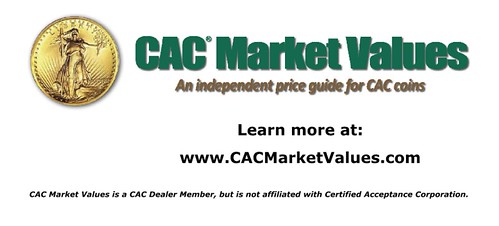
NEW BOOK: THE IBNS INTRODUCTION TO BANKNOTES
Martin Kaplan passed along this notice of a new publication from the International Bank Note Society (IBNS). Thanks. -Editor
 The IBNS Introduction to Banknotes and Banknote Collecting
The IBNS Introduction to Banknotes and Banknote Collecting
Are you interested in finding out more about banknotes and banknote collecting?
Do you know
- how banknotes are manufactured?
- the different features that can appear on a banknote and why they are there?
Have you thought about starting a banknote collection but want some information about
- where to start
- the equipment you need
- how to look after your collection
- the different grades and condition of banknotes
Members of the International Bank Note Society (IBNS) with many years of experience of banknotes and banknote collecting have produced
Aimed at beginners, it includes answers to those questions as well as the definition of a banknote, its various features and how banknotes are manufactured, as well as an outline of aspects to be considered when building a collection of banknotes including information on how to grade a banknote.
If you want to take your interest in Banknotes even further, why not consider joining the International Bank Note Society?
Membership of the IBNS has numerous benefits which include:
- bringing together people with a common interest in banknotes
- the award winning IBNS Journal produced quarterly which includes articles covering all aspects of banknotes as well as the Society’s activities
- a forum on the IBNS Website for members to discuss matters and ask questions
To gain the most from an interest in banknotes, membership of the IBNS is recommended. Membership of the IBNS costs $36.00 USD (£28.00 GBP or $48.00 AUD) per year.
To become a member please complete an application form - https://www.theibns.org/join
To read the book, see:
The IBNS Introduction to Banknotes and Banknote Collecting (https://www.theibns.org/intro-to-banknotes/)
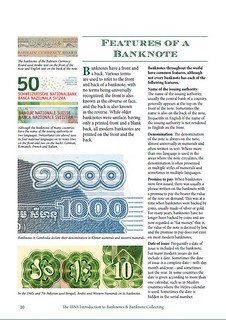

Booklets for newbies to the hobby are excellent tools for specialty organizations. We do have some basic information on the NBS web site, but publishing something like this for numismatic literature would be a great project. -Editor
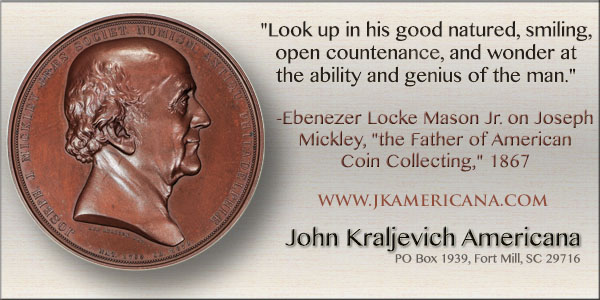
BOOK REVIEW: SO-CALLED DOLLARS PACIFIC COAST EXPOS
John and Nancy Wilson submitted this review of Jeff Shevlin's new book on the So-Called Dollar medals of Pacific Coast expositions. Thanks! -Editor
 Previously we reviewed a pocket price guide of this current hard bound edition. This review is of the So-Called Dollars from The Pacific Coast Expositions,
1894-1962 authored by Jeff Shevlin and Professor William D. Hyder. This hard-bound reference has 300 pages, fully illustrated, and contains 300 color photographs. The preface
is by well-known numismatist and author Q. David Bowers and he states “I thought I knew a lot about so-called dollars, but now I know much more.” The heart of the book is the
in-depth analysis of all of the so-called dollars, their rarities and other historical U. S. medals that are associated with those great expositions.” The reference also has
dozens of previously unknown medals and varieties.
Previously we reviewed a pocket price guide of this current hard bound edition. This review is of the So-Called Dollars from The Pacific Coast Expositions,
1894-1962 authored by Jeff Shevlin and Professor William D. Hyder. This hard-bound reference has 300 pages, fully illustrated, and contains 300 color photographs. The preface
is by well-known numismatist and author Q. David Bowers and he states “I thought I knew a lot about so-called dollars, but now I know much more.” The heart of the book is the
in-depth analysis of all of the so-called dollars, their rarities and other historical U. S. medals that are associated with those great expositions.” The reference also has
dozens of previously unknown medals and varieties.
The table of contents contains a dedication by Jeff Shevlin to his best friend Professor Hyder, the book covers the eight expositions from 1894 to 1962. It is not a price guide, but a very thorough review of the Pacific Coast Expositions and a very comprehensive study of its medals. You need the Pacific Coast Expositions Annual So-Called Dollar Collectors Pocket Price Guide for the prices.
The first exposition was held in Paris in 1844. The people marveled at the monumental excesses of neoclassical architecture housing splendid inventions and products of the Industrial Revolution.
The 1876 Exposition was the second exposition or fair held in America. This event had an attendance of 10 million people which was 20% of the population. A generation later the Chicago 1893 Fair had an attendance of 27 million visitors, which was 40% of the population. A list of all of the U. S. Expositions from the New York Crystal Palace event in 1853 to the New York World’s Fair in 1964 is given. There are dozens of other types of tokens and medals which are included with so-called dollars. Abbreviations for all metal compositions are given along with a rarity guide for all so-called dollars.
Eight Pacific coast expositions between 1894 to 1962 cover the many related tokens, medals and other numismatic items during this period. Jeff and Bill’s love, passion, knowledge and the history surrounding them for the Pacific Coast Expositions is covered thoroughly. Enlarged photos of all the known and newly discovered So-Called Dollars are illustrated
The 1894 California Midwinter International Exposition. The exposition hired mint engraver Charles Barber to design and cut the dies for their official medal.
The 1905 Lewis and Clark Centennial Exposition covers so-called dollars along with wooden money post cards, ephemera, admission ticket, advertisements, circulars, photos of Hart and Zerbe, Louisiana gold, and a chart dealing with die attribution.
The 1909 Alaska-Yukon-Pacific Exposition highlights the economic impact of the gold discoveries in Alaska and the Yukon Territory along with the importance of Seattle during the late 1800s and early 1900s.
The 1915 Panama-Pacific International Exposition was held in San Francisco and the 1915-1916 Panama-California Exposition was held in San Diego. They celebrated the opening of the Panama Canal. The rationale for the Panama-California Exposition was that the Port of San Diego was the nearest U. S. port for ships traveling through the Panama Canal.
The 1935-1936 California Pacific International Exposition. The exposition was to promote world peace and generate funds to save the deteriorating Balboa Park location which had housed the 1915-1916 expo.
The 1936-1940 Golden Gate International Exposition was held in San Francisco because of the success of the past two expos held there.
The 1962 Century 21 Exposition was held in Seattle and had a display of 1,000,000 silver dollars. The most interesting thing at the expo was the Space Needle which still exists today.
We never knew that collectors of so-called dollars had annual meetings which started in 2014 and special limited-edition medals have been made for the events. If you collect SCDs and would want to attend the next event you can contact the authors to find out about their next meeting. The author used a vast array of collectors, dealers and other sources – including Internet discussion boards who contributed with perhaps 1000 posts.
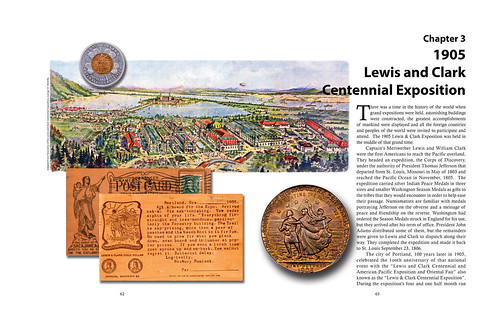
Pages 62 and 63 from Chapter 3 cover portions of the 1905 Lewis and Clark Centennial Exposition.
The reference is outstanding and after you consider the authors have put their lives work and vast knowledge of the subject into each and every chapter it is a terrific read. You will also gain knowledge of not only the SCDs issued for the various expositions but also the highly interesting and entertaining history of how they came about. To go along with this reference, we also recommend that you purchase the inexpensive, So-Called Dollar Pocket Price Guide, 2018 which we reviewed a few months ago. Both would make great Christmas gifts to yourself or your numismatic friends To purchase the So-Called Dollars From The Pacific Coast Expositions, 1894-1962 the cost is $59.95 plus $4.50 shipping. Send to Jeff Shevlin, the So-Called Guy, 1894 E. William Street, Suite 4-240, Carson City, NV 89701, Phone (916) 955-2569, Email SoCalledGuy@Hotmail.com or visit the web page at www.So-CalledDollar.com .
To read the earlier E-Sylum articles, see:
NEW BOOK: SO-CALLED DOLLARS PACIFIC COAST EXPOS (https://www.coinbooks.org/v21/esylum_v21n44a04.html)
NEW BOOK: PACIFIC COAST EXPO SO-CALLED DOLLARS (https://www.coinbooks.org/v21/esylum_v21n25a04.html)
BOOK REVIEW: PACIFIC COAST EXPO SO-CALLED DOLLARS (https://www.coinbooks.org/v21/esylum_v21n24a04.html)

LEVICK, MEHL, AND BOWERS
In his December 07, 2018 Stack's Bowers blog, Dave Bowers discusses Joel Orosz's recent Coin World Numismatic Bookie column. -Editor

I was honored to be featured in the latest installment of “The Numismatic Bookie,” Joel J. Orosz’s popular column in Coin World. It began with:
“Three numismatic auction catalogs are illustrated on this page, each produced in a different century. Remarkably, however, the careers of the three men associated with them as collectors and dealers form an unbroken line covering nearly all of American numismatic history, beginning in the 1850s, and continuing to the present.”
Shown and discussed first was a catalog of the collection of Joseph Napoleon Tricot Levick (1828-1908), a leading numismatic figure from the 1850s onward, whose specialties were wide and included 1793 large cents, tokens (in particular), and other series. His name usually appeared as J.N.T. Levick. Dr. Orosz notes that by the time of Levick’s passing in 1908, Fort Worth, Texas dealer B. Max Mehl was prominent, having started in the trade circa 1900. Perhaps the two may have met – or perhaps not. For certain, their careers overlapped.
The second catalog was of the Frederic Geiss Collection sold by Mehl (1884-1957) in 1947. I had the good fortune of knowing Mehl in the twilight of his life. At a dinner with him, Abe Kosoff, and Mollie Kosoff, I suggested that he write his autobiography. By that time I had read all of his catalogs and much about his life. “Why don’t you write it for me?” he suggested. With that I return to the text of “The Numismatic Bookie”:
“The third catalog, created by Quentin David Bowers (born 1938), is The Rarities Sale of July 31, 2002, featuring multiple collections. Dave has enjoyed an unparalleled career in numismatics, becoming a coin dealer in 1953, while in high school, and continuing up to the present day, in the process handling such immortal numismatic collections as Garrett, Brand, Norweb, and Eliasberg. Even more impressive are his authorial credentials, having written more than 60 books on numismatic subjects, and having served as a Coin World columnist since the early 1960s! Shortly after starting his business, Dave interviewed B. Max to learn about coin dealing from the acknowledged master. Dave imbibed Mehl’s lively descriptions, but added strong emphasis upon the history, art and romance of coinage. The results showed, for in The Rarities Sale, a 1793 Chain America cent, “sharpness of EF-40, but repaired and tooled,” went for $5,290, while an MS-63 BN lettered edge Wreath Cent sold for $18,400. Despite having already secured a central place in numismatic history, Dave continues to deal and write (see elsewhere in this issue for the latest of his nearly 3,000 Coin World columns)!
“J.N.T. Levick, B. Max Mehl, and Q. David Bowers have far more in common than the use of initials in place of their first names. Their brilliant careers as collectors, dealers, authors, and hobby builders began before the Civil War, and has overlapped, uninterrupted, to the present. These three catalogs associated with them underscore how much (particularly prices) has changed during those 16 decades, and how much (particularly rarity), has remained unaltered. And think of how young numismatists who have worked with Dave, such as Kellen Hoard, bid fair to carry that uninterrupted streak into its fourth century!”
To read the complete article, see:
Three Degrees of Numismatic Separation!
(https://www.stacksbowers.com/News/Pages/Blogs.aspx?ArticleID=3201)
WALTER DOUGLAS ALLAN (1933-2017)
Canadian numismatist Walter Allan disappeared July 18, 2017 and is now presumed dead. Here is an excerpt from an article in The Globe and Mail. -Editor
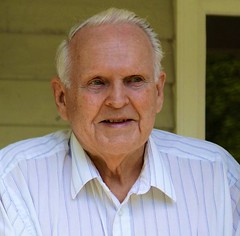 It only made sense that Walt would serve as unofficial guardian of our family history. A lifelong pack-rat, he kept everything – old car keys, expired calendars, every
single sales receipt; a butterfly collection started as a child and, literally, thousands of photos of clouds he’d snapped with his little red Nikon.
It only made sense that Walt would serve as unofficial guardian of our family history. A lifelong pack-rat, he kept everything – old car keys, expired calendars, every
single sales receipt; a butterfly collection started as a child and, literally, thousands of photos of clouds he’d snapped with his little red Nikon.
Like many born during the Great Depression, Walt could not throw anything away. At the end of his life, he had 11 alarm clocks in his small home. A few of them even worked.
From childhood until retirement, Walter worked at Allan’s Drug Store, the Lake Shore Boulevard pharmacy that his parents purchased in 1939. Even as a kid, he knew everyone in the town of Bronte, Ont., (now part of Oakville) – with thanks to his Globe and Mail paper route. Open even on Christmas Day, pharmacy hours always informed the timing of the turkey dinner.
Walt was an exuberant collector of stamps and coins, but also rocks, marbles, maps, pharmacy paraphernalia, seashells, cameras and, especially, anything connected to Bronte’s roots. In 1988, he spearheaded a campaign to save the Sovereign House, a heritage home that would become a showcase of local history.
By far his greatest passion was for collecting and cataloguing paper money, rare banknotes and vignettes. A distinguished expert, he led the Canadian Paper Money Society from 1993 to 1995 and was later named an honorary president.
In July, 2017, he left his Tobermory home for the annual gathering of the Royal Canadian Numismatic Association in Boucherville, Que. He never made it. Walter’s car was later found abandoned in a farmer’s field an hour east of the convention. Police searched for days. They ended their investigation several months later, though he was never found.
To read the complete article, see:
Dedicated numismatist Walter Allan was also a favourite
uncle and small-business owner (https://www.theglobeandmail.com/life/article-dedicated-numismatist-walter-allan-was-also-a-favourite-uncle-and/)
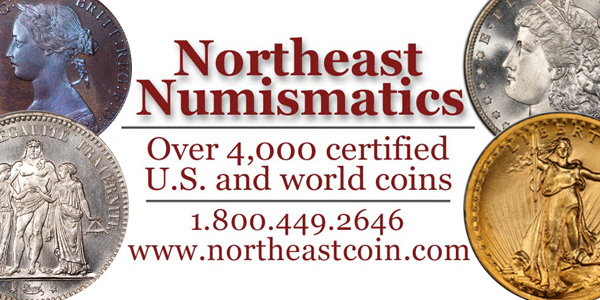
IDAHO TRADE TOKEN NEWSLETTER ON NEWMAN PORTAL
The latest addition to the Newman Numismatic Portal is the Idaho Trade Token Newsletter. Project Coordinator Len Augsburger provided the following report. Thanks. -Editor
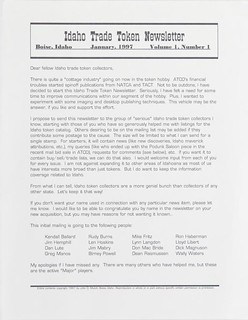 Recently added to the Newman Portal is John Mutch’s Idaho Trade Token Newsletter for the period 1997-1999. Token collectors frequently collect by state, and
these pieces offer a historical connection between the collector and the businesses of bygone days. The first issue discusses accounting records of the Midway Bar (Boise) in 1911
– quite profitable, especially during the winter months. Also included is a note from the 1910 Wardner News noting the county crackdown on dance halls and their “gambling,
dancing & kindred vices.” Mutch notes related 10-cent tokens from these mining town establishments. The exhaustive reference site, tokencatalog.com, identifies one such piece,
from the J. Farrin & Co. dance hall in Wardner.
Recently added to the Newman Portal is John Mutch’s Idaho Trade Token Newsletter for the period 1997-1999. Token collectors frequently collect by state, and
these pieces offer a historical connection between the collector and the businesses of bygone days. The first issue discusses accounting records of the Midway Bar (Boise) in 1911
– quite profitable, especially during the winter months. Also included is a note from the 1910 Wardner News noting the county crackdown on dance halls and their “gambling,
dancing & kindred vices.” Mutch notes related 10-cent tokens from these mining town establishments. The exhaustive reference site, tokencatalog.com, identifies one such piece,
from the J. Farrin & Co. dance hall in Wardner.
Thanks to John Mutch for granting permission and loaning physical copies for scanning.

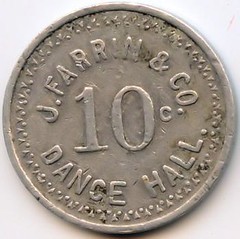
Images: J. Farrin & Co. 10-cent check, courtesy of Steve Hayden on tokencatalog.com
Link to Idaho Trade Token Newsletter on Newman Portal:
https://nnp.wustl.edu/library/publisherdetail/529431
Link to J. Farrin & Co. token on tokencatalog.com:
http://tokencatalog.com/token_record_forms.php?action=DisplayTokenRecord&td_id=366157&inventory_id=351887
&td_image_id=196850&attribution_id=374739&record_offset=1
ON BLOGS IN THE SOCIAL MEDIA AGE
The E-Sylum was a blog before the word or tools were invented. Facebook, Twitter and Instagram are great, but for the creation of high-quality content, the slower-paced human-edited blog still has a place.
Cal Newport is a computer science professor who writes about the intersection of technology and society. He's particularly focused on the impact of new technologies on people's ability to perform productive work and lead satisfying lives. I've been a fan for a while and really admire his work. His December 7, 2018 blog post examines what makes the now seemingly old-fashioned blog still relevant in today's faster paced social media world. -Editor
Earlier this week, Glenn Reynolds, known online as Instapundit, published an op-ed in USA Today about why he recently quit Twitter. He didn’t hold back, writing:
“[I]f you set out to design a platform that would poison America’s discourse and its politics, you’d be hard pressed to come up with something more destructive than Twitter.”
 What really caught my attention, however, is when Reynolds begins discussing the advantages of the blogosphere as compared to walled garden social media platforms.
What really caught my attention, however, is when Reynolds begins discussing the advantages of the blogosphere as compared to walled garden social media platforms.
He notes that blogs represent a loosely coupled system, where the friction of posting and linking slows down the discourse enough to preserve context and prevent the runaway reactions that are possible in tightly coupled systems like Twitter, where a tweet can be retweeted, then retweeted again and again, forming an exponential explosion of pure reactive id.
As a longtime blogger myself, Reynolds’s op-ed got me thinking about other differences between social media and the blogosphere…
Attention Markets
One of these differences that has consistently caught my attention is the way in which social media reconstructed the market for online attention.
Blogs implement a capitalist attention market. If you want attention for your blog you have to earn it through a combination of quality, in the sense that you’re producing something valuable for your readers, and trust, in the sense that you’ve produced enough good stuff over time to establish a good reputation with the fellow bloggers whose links will help grow your audience.
Succeeding in this market, like succeeding with a business venture, can be ruthlessly difficult. There’s lots of competition for the attention you’re trying to attract, and even skilled writers often find that something about their voice, or the timing of their topic, fails to catch on.
Social media, by contrast, implements a collectivist attention market, where the benefits of receiving attention are redistributed more uniformly to all users.
A key dynamic driving the popularity of platforms like Facebook and Instagram, for example, is the following notion: if you like me, I’ll like you. As I noted in Deep Work, if you took the contents of the standard Facebook or Instagram feed and published it on a blog, it wouldn’t attract any readers, or comments, or links.
See Cal's complete post online for of his thoughts on the key dynamics of social media platforms and the tradeoffs with blogs. Sign up for his if you like - he's a deep thinker with a lot to say. Here's his summary. -Editor
Capitalist attention markets, on the other hand, offer one decidedly important advantage: better content. To state the obvious, there are plenty of bad blogs. But in the blogosphere it’s easy to filter these from the more serious contributors that, through the traits of quality and trust cited above, distinguish themselves as worthwhile.
As any serious blog consumer can attest, a carefully curated blog feed, covering niches that matter to your life, can provide substantially more value than the collectivist ping-ponging of likes and memes that make up so much of social media interaction.
In other words, Glenn Reynolds was on to something when he stepped away from Twitter and began to reminisce about what once made blogging seem so exciting.
Deleting your accounts as a user is extreme and not necessary as long as you're an aware consumer; but for good curated content be sure to seek out, consume and support quality blogs. For an example of how the blogs interact, see the exchange in a later article in this issue with new subscriber JP Koning, an economics blogger. -Editor
To read the complete article, see:
On Blogs in the Social Media Age
(http://calnewport.com/blog/2018/12/07/on-blogs-in-the-social-media-age/)
To read Glenn Reynolds' excellent Op-Ed, see:
I deleted my Twitter
account. It's a breeding ground for thoughtlessness and contempt.
(https://www.usatoday.com/story/opinion/2018/12/03/twitter-facebook-social-media-bias-political-poison-blogosphere-instapundit-column/2183648002/)

READERS REMEMBER RICHARD MARGOLIS
Frank Robinson writes:
Dick Margolis — 87! Yowtch. I had not realized he was up there. I remember him as a young(ish) feller. Well, it’s been half a century. I bought a lot of coins from him back in the day. Many French ones still in my collection. One I particularly remember was an 1852 Franc, scarce one-year-type, in gorgeous quality.
He was always a very fine gentleman, a pleasure to deal with. Likewise his lovely wife Sara, always at his table.
There was also a guy in my local area named John Kirkpatrick, who was a supreme enthusiast for French coins, and was always talking about the treasures he bought from Margolis. John would show a coin, and say, “Choice, choice, choice.” John is long gone too.
Time marches on. One day you’ll get a message like this from David Vagi saying “Frank Robinson — 103! I remember buying coins from him when I was a kid.”
Alan V Weinberg writes:
I knew and bought from Dick Margolis for many decades. He was a numismatist of the "old school", a real gentleman, soft spoken and as eager to impart or receive information as to sell, his profession. His wife Sara , an attractive blond lady, always had a smile and would eagerly show you trays of tokens or medals if Dick was occupied.
He often traveled to Europe and had access to the "hidden archives" of European dealers, bringing back treasures inaccessible to others. He exhibited his Benjamin Franklin cameos and Jean Baptiste Nini Terra cotta medallions at major NY shows...I recall decades ago Tony Terranova and I salivating over these delicacies on exhibit.
Dick's eyesight slowly faded over the past decade or so but he lived a good long life and will be fondly remembered both here and in Europe.
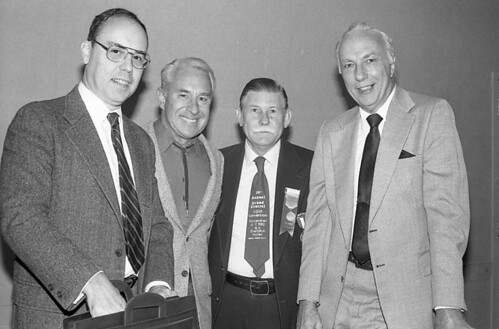
Richard Margolis, Donald Partrick, Vincent Alones, John J. Ford. Margolis and Ford were educational forum speakers, Partrick was the MC and Alones was the Long Island Coin Club's 1986 Grand Central Coin Convention General Chairman
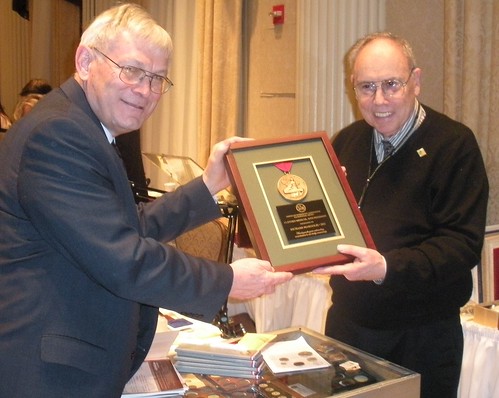
Clifford Mishler presents Richard Margolis a 2011 ANA Presidential Award during the New York International Numismatic Convention.
George Cuhaj sent the above photos and captions. Thanks, everyone! -Editor
To read the earlier E-Sylum article, see:
RICHARD MARGOLIS (1931-2018) (https://www.coinbooks.org/v21/esylum_v21n48a06.html)

NOTES FROM E-SYLUM READERS: DECEMBER 9, 2018
Query: Kliman Two-Cent Piece Video Sought
Alan Meghrig writes:
I am looking for help from E-Sylum readers in locating a video on US 2¢ pieces. I would like to locate a copy to arrange sale or loan or duplicate copy. The video (VHS) was released about 1983. The primary personality was Mike (Myron) Kliman discussing US. 2¢ pieces. Any help would be appreciated.
Does anyone remember this video? Have a copy or know someone who does? The Newman Numismatic Portal has a few other videos on the topic, linked below. -Editor
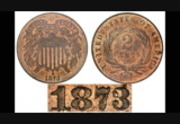 To watch the videos on NNP, see:
To watch the videos on NNP, see:
Two Cent Piece Collecting (https://nnp.wustl.edu/library/book/544789)
History and Collecting of Two-Cent Coins (https://nnp.wustl.edu/library/book/544811)
Two Cent Piece Video US Mint Series (https://nnp.wustl.edu/library/book/523246)
A Thank-You From David Lange
David Lange writes:
While it's not common knowledge that I've been battling cancer, enough persons have sent me well wishes that I want to make a public thank you for their thoughtfulness. I'm done with surgery, at least for now, and chemotherapy and radiation treatment will commence soon. It's my hope that this will put an end to the matter. I expect to be back to work shortly, even while treatment continues.
Best wishes to Dave with his continued treatment and recovery. -Editor
Homemade Indian Cent Coin Board

David Lange's Winter 2019 Coin Board News included an interesting handmade coin board. Thanks to Dave for providing the illustration. -Editor
One oddity I purchased recently is a homemade coin board of standard size that is neatly hand lettered to replicate a Kent or First Edition Whitman board for Eagle & Indian Cents. Even the incorrect spelling “NICKLE” is repeated, though this board omits both the rare 1856 cent and a backing.
QUERY: EXPORT-IMPORT BANK CERTIFICATE
Xris Thomas began reading The E-Sylum six months ago and has a question for our readers. Can anyone help? -Editor
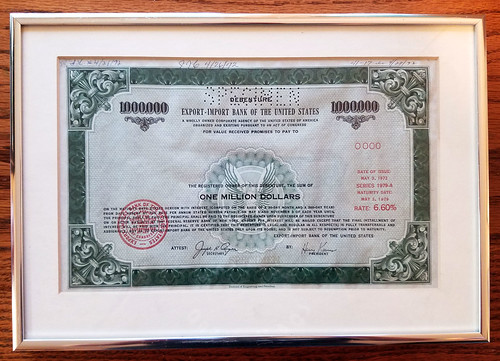
I'm trying to find information on this "debenture" stock certificate for a friend of mine, and I'm having a dickens of a time doing so. It's possible they were never made as it does state "specimen" towards the top, but the dates and notes handwritten above lead me to believe otherwise and that an act was possibly passed to make them a reality? Regardless, I find it pretty cool that it was made out for such a large amount ($1,000,000!), and in the meantime I'm just going to pretend we have the only one in the world and it is worth multiples of that ;)
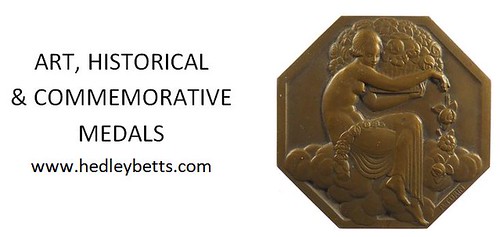
VOCABULARY TERMS: BELL METAL, BEESWAX
Dick Johnson submitted these entries from his Encyclopedia of Coin and Medal Terminology. Thanks. -Editor
Bell Metal The bronze alloy for making bells can be used successfully for striking or casting medals. Bell metal alloy is best at 78 parts copper to 22 parts tin (which has a specific gravity of 8.7 and a melting point of 870° centigrade); but any alloy of 3 to 5 parts of copper to 1 of tin have been used for bell making. The first reference to a medal in bell metal is a Desiderius Erasmus Medallion of 1519 by Quentin Massys (Kress 629a). See bronze, composition (2).
Beeswax A type of wax noted for its ductile yet hard qualities. It can be carved and cut at room temperatures, or can be melted and cast, then worked on again. When mixed with clays it can form a soft modeling material, it is a component of plasticine. At normal temperature beeswax is used by medallic companies to make an intermediate reduction on a pantograph. It is also used as an acid resistant material in acid etching. See wax.
Looking for the meaning of a numismatic word, or the description of a term? Try the Newman Numismatic Portal's Numismatic Dictionary at: https://nnp.wustl.edu/library/dictionary
Or if you would like a printed copy of the complete Encyclopedia, it is available. There are 1,854 terms, on 678 pages, in The Encyclopedia of Coin and Medal Technology. Even running two a week would require more than 19 years to publish them all. If you would like an advance draft of this vital reference work it may be obtained from the author for your check of $50 sent postpaid. Dick Johnson, 139 Thompson Drive, Torrington, CT 06790.

GEORGE AYER LEAVITT (1822-1888)
 George A. Leavitt was a well-known bookseller, publisher, auctioneer, and principal of one of New York City's top auction houses well known for selling rare books,
art, antiques, autographs, coin, and stamp collections.
George A. Leavitt was a well-known bookseller, publisher, auctioneer, and principal of one of New York City's top auction houses well known for selling rare books,
art, antiques, autographs, coin, and stamp collections.
George Ayer Leavitt (1822-1888), was born on May 13, 1822, at Haverhill, Essex County, Massachusetts, son of Jonathan Leavitt (1797-1852), a bookbinder, and Joan Ayer Leavitt (1795-). About 1825, the family left Massachusetts moving to New York City where Jonathan Leavitt entered into a partnership with his brother-in-law Daniel Appleton opening a publishing and bookselling business. That firm dissolved when Jonathan Leavitt opened a new firm with John F. Trow, called Leavitt & Trow.
George Leavitt studied and graduated from the nation's oldest incorporated private school, Phillips Academy, founded 1778, Andover, Massachusetts.
In 1842, he worked as a book dealer for Robinson & Franklin.
After his father's death in 1851, he continued the family firm.
In January 1852 he was a partner with John K. Allen in Leavitt & Allen, publishers and booksellers holding auctions and began his first annual New York Trade Sales, 379 Broadway, corner of White Street
His father-in-law, James Ewing Cooley (1802-1882), a famous New York book dealer and publisher since 1833 had given Lemuel Bangs (1808-1887) his start, now suggested to his son-in-law, George A. Leavitt, that he join his business publishing and begin holding book auction Trade Sales. From this period on Leavitt became a widely known auctioneer.
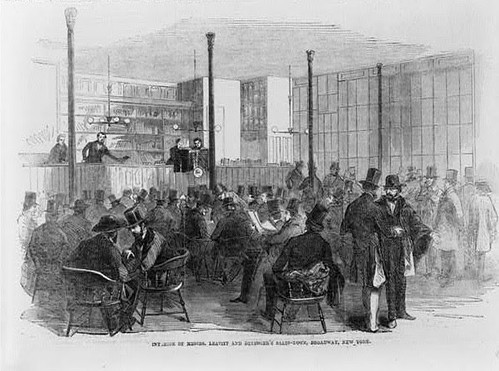
He joined the Army during the Civil War. The commercial paper held by southern businesses was now worthless and the book business became solvent.
From 1867-1871, he opened Clinton Hall Book Sale Rooms, Astor Place & 8th Street, New York.
In 1870, on the retirement of John K. Allen, the firm of Leavitt & Allen Bros. became World Publishing Company. This firm dissolved in 1878.
From 1871-1884, he once again renamed the firm George A. Leavitt & Company, Clinton Hall Book Sale Rooms, Astor Place & 8th Street, New York.
He died on December 18, 1888.
To read the complete article, see:
LEAVITT, GEORGE AYER
(https://sites.google.com/a/numismaticmall.com/www/numismaticmall-com/leavitt-george-ayer)
The entire inventory of the Lupia Numismatic Library is for sale. Individual items will be available before the remaining archives are broken up into parcels sold at philatelic auctions in the U. S. and Hong Kong. Check NumismaticMall.com frequently as dozens of new items with estimates will be posted daily until everything is sold.
All inquiries will be given prompt and courteous attention. Write to: john@numismaticmall.com .

CLASSICAL NUMISMATIC GROUP TRITON XXII SALE
Here is the press release for Classical Numismatic Group's January NYINC sale, Triton XXII. Some beautiful classic coins. -Editor
Features Multiple Collections & Individual Rarities
Classical Numismatic Group, LLC of Lancaster, Pennsylvania and London, England is proud to present Triton XXII, a Public, Internet, and Mail Bid Sale to be held in conjunction with the 47th Annual New York International Numismatic Convention (NYINC) on January 8-9, 2019. The 2019 NYINC will be held at the Grand Hyatt Hotel, located at 109 East 42 nd Street, New York, NY 10022, between Park and Lexington Avenues.
Triton XXII features 1456 lots of Greek, Celtic, Oriental Greek, Central Asian, Roman Provincial, Roman Republican & Imperatorial, and Roman Imperial coinage. Additionally, there are featured selections of Byzantine, Early Medieval, Islamic, World, and British coinage, as well as a nice selection of large lots. The pre-sale estimate total for Triton XXII is just shy of $8 million.
Triton XXII is highlighted by a number of collections and individual rarities, which make up the majority of coins on offer:
- Exceptional Greek and Roman Coins from the Gasvoda Collection with an emphasis on Magna Graecia and Sicily
- A Published Athens Dekadrachm from the Spina Collection
- Seleukid Coinage from the MNL Collection
- Extremely Rare and Spectacular Philistian Imitations of the Athenian Dekadrachm
- Rare Egyptian Coins from the Collection of a Northern California Gentleman
- Selections of Greek and Roman Coins from the DMS Collection
- The Michel Prieur Collection of Syro-Phoenician Silver Coinage
- Roman Republican Coins from the Alan J. Harlan Collection
- Roman Gold Coins from the Heath Collection
- Iconic First Year Post-Reform Dinar from Damascus
- A Date Set of Umayyad Dinars
- Two Class A Zodiac Type Mohurs – Aries and Pisces
- Early Medieval and Anglo-Saxon Coins from the Londinium Collection
Lot viewing for Triton XXII will begin on Sunday, January 6th , from 1PM until 7PM in the Broadway Room, located on the Conference Level (CC floor) of the Grand Hyatt Hotel.
The complete lot-viewing schedule for Triton XXII is:
Sunday, January 6, 2019 – 1PM until 7PM;
Monday, January 7, 2019 – 9AM until 7PM;
Tuesday, January 8, 2019 – 8AM until 6PM; and
Wednesday, January 9, 2019 – 8AM until Noon.
Auction lots will also be available for viewing at the Pennsylvania offices of CNG from Wednesday, December 5th , 2018 until Friday, December 21st , 2018 by appointment only. Please note that CNG’s office hours will be limited during the holiday season.
The auction sessions for Triton XXII will be held in the Empire State Ballroom I, located on the Ballroom Level (B floor) of the Grand Hyatt Hotel. Triton XXII will be conducted over four sessions with the morning sessions beginning promptly at 9:30 AM on Tuesday, January 8th , and Wednesday, January 9th , 2019, and the afternoon sessions will start at 2 PM on the same days.
In addition, there will be an online, Internet-only, Session 5 for Triton XXII, which CNG will be conducting as our Electronic Auction 436, and will open for bidding on January 2nd , 2019. E-Sale 436 will feature over 1,000 lots, with a closing date of Wednesday, January 23 rd , 2019, and will include coins from some of the same collections listed above.
Printed catalogs for Triton XXII are now available. To order a catalog, please visit www.cngcoins.com. The catalog is $75 to North American addresses, and $100 to the rest of the world. Payment may be made by U.S. $ check or Visa/MasterCard. Catalogues have already been mailed to customers on CNG’s active mailing list.
CNG is currently accepting consignments for its next Mail Bid and Internet auction, CNG 111, scheduled for May 8th , 2019. The consignment deadline is Friday, January 25 th , 2019.
For further details and any additional information, please contact CNG, LLC at:
Classical Numismatic Group, LLC P.O. Box 479 Lancaster, PA 17608-0479 Telephone: (717) 390-9194 Fax: (717) 390-9978 Email: cng@cngcoins.com
About the NYINC:
The New York International Numismatic Convention is the United States’ most prestigious numismatic event targeting the needs of the world and ancient numismatic communities.
The 47th Annual NYINC will be held at the Grand Hyatt Hotel, located at 109 East 42 nd Street, New York, NY 10022, between Park and Lexington Avenues. The dates for the 2019 NYINC
are Friday, January 4th , 2019 through Sunday January 13th , 2019, with bourse activities taking place Thursday-Sunday, January 10-13, 2019.
Just a few of the individual highlights from Triton XXII are:
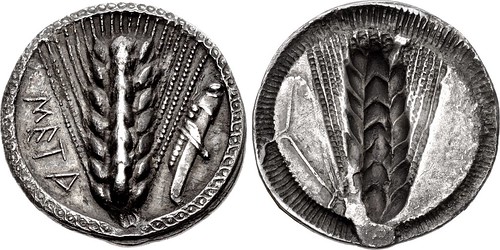
Lot 18–LUCANIA, Metapontion. Circa 540-510 BC. AR Nomos (28.5mm, 6.89 g, 12h). Ear of barley with seven grains; META down left field, grasshopper upward to right / Incuse ear of barley with seven grains; outline of dolphin upward to left. Noe Class V, 100 (same dies); HN Italy 1472; SNG ANS 206 (same dies); Basel 130 (same dies); Gillet 132 (this coin); Kraay & Hirmer 229 (same dies). Near EF, toned, die breaks on reverse (diagnostic for die). Estimated at $20,000
From the Gasvoda Collection. Ex Numismatica Ars Classica 92 (23 May 2016), lot 88; A. D. Moretti Collection; Numismatica Ars Classica 18 (29 March 2000), lot 22; Numismatica Ars Classica 9 (16 April 1996), lot 57; Leu 42 (12 May 1987), lot 46; Charles Gillet Collection.
From the consignor: The most interesting type of the incuse coinage of Metapontum certainly must be the issues that include the locust (or grasshopper) design detail, as here. There are a number of variations. Here it is paired with a dolphin in outline. The locust would have been a serious threat to the agricultural community and likely the dolphin relates to Apollo who would have been seen as the God who eliminated a plague of these insects in the year this coin was struck.
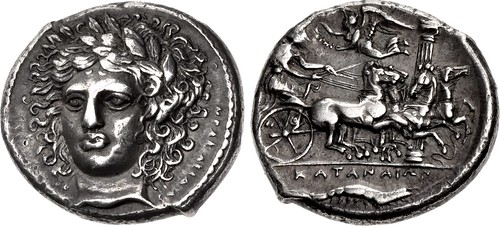
Lot 120–SICILY, Katane. Circa 405-403/2 BC. AR Tetradrachm (27mm, 17.18 g, 12h). Obverse die signed by Herakleidas. Head of Apollo facing slightly left, wearing laurel wreath; HPAK?EI?AS to right / Charioteer, holding kentron in right hand, reins in both, driving fast quadriga right; above, Nike flying left, crowning charioteer with open laurel wreath held in both hands; Ionic column in right background; in exergue, KATANAION above crawfish right. Mirone 61 (same dies as illustration); HGC 2, 576; SNG ANS 1257 (same rev. die); BMC 33 (same dies); Gillet 400 = Jameson 547 (this coin); cf. Gulbenkian 192/193 (for obv./rev. dies); Hirsch 339 (same dies). Good VF, lovely old collection tone, a few marks under tone. Very Rare. A classic piece from the era of the Sicilian masters with a delightful portrait of Apollo in superb style. Estimated at $100,000
From the Gasvoda Collection. Ex America Collection (Numismatica Ars Classica 96, 6 October 2016), lot 1014; New York Sale XX (7 January 2009), lot 74; de Guermantes Collection (Leu 86, 5 May 2003), lot 269; Leu 18 (5 May 1977), lot 59; Charles Gillet Collection; Robert Jameson Collection; Gustave Durulfé Collection (not in Rollin et Feuardent sale); Billoin Collection (Rollin et Feuardent, 22 March 1886), lot 184 (not illustrated, but cited by Jameson).
Founded about 730/29 BC by the colonists from the neighboring Chalkidian colony of Naxos, the city of Katane was located on the eastern coast of Sicily on the fertile Katanian plain near the southern limits of the lava flows from Mt. Aitna. Like its neighbor to the north, Leontini, the city prospered from its exploitation of the fertile plain for the production of barley. When it began striking coinage in the mid-fifth century BC, Katane included on its issues the local river, Amenanos, which was responsible for the fertility of the soil. Like other contemporary Greek riverine depictions, the river-god is portrayed as a human-headed bull (see lot 117 above). Later issues, however, perhaps influenced by other regional coinages, give the river-god a more youthful and androgynous appearance.
Katane's prosperity attracted the attention of its immediate and more-powerful neighbor Syracuse. In 476 BC, Hieron I expelled the population from Katane, driving them north to Leontini. In turn, Katane was "refounded" with a new body of colonists consisting of Syracusan citizens and Dorian mercenaries. Renamed Aitna, it issued a short-lived and very rare coinage, featuring the head of Silenos on the obverse and either Zeus or his thunderbolt on the reverse. This Syracusan overlordship was short-lived, and in 461 BC the original inhabitants of Katane were restored to the city, while the inhabitants of Aitna were withdrawn to the fortress of Inessa, which they renamed Aitna. To commemorate the reinstatement of its original inhabitants, Katane struck a remarkable series of tetradrachms featuring the river-god Amenanos on the obverse and Nike holding a wreath, diadem, or fillet on the reverse. Several different adjuncts, such as a Silenos or a ketos are included on the obverse as well. Such additions may be evidence of regional influences resulting from Katane's recent history. Such is the case after about 460 BC when this issue was replaced by one featuring a quadriga similar to that of Syracuse, but without the additional Nike, on the obverse and the laureate head of Apollo, similar to that of Leontini, on the reverse (see lot 118 above).
Katane continued to prosper until the late 5th century BC, when the city entered a period when it became continually embroiled in conflicts between other states. In 415 BC, Katane was attacked and captured by Athens, which used the city as the base of operations for the first year of the famous Sicilian Expedition. Later, in 403 BC, Katane fell to Dionysios I of Syracuse, who, like Hieron I before him, re-founded the city, this time with Campanian mercenaries. In the period leading up to this conflict with Syracuse, the coinage of Katane underwent another transformation. By the late 5th century BC, the numismatic art of Sicily had achieved an unparalleled degree of quality in the Greek world. This was due in large part to the great masters whose signatures are boldly displayed on their minute canvasses: Choirion, Euainetos, Eumenos, Exakestidas, Kimon, and others. Most of these artists are known from their work in the Syracusan series, but a few also created masterful works of art at other cities as well. One of these, Herakleidas, created a magnificent facing head type that is a standout among the famed Katanean issues. Certainly influenced by the Kimonean facing-head portraits of Arethusa on tetradrachms at Syracuse, the subject here was the god Apollo, whose profile portrait was featured on the reverse of earlier issues of Katane.
Here, the god's portrait has become the prominent feature of the coin, moving to the obverse and appearing in a nearly frontal aspect. One may sense Herakleidas' attempt to portray Apollo in a naturalistic form, retaining through his countenance an attitude of an other-worldly god, while introducing a delicacy that conveys the thought of a living being. The hair falls in individual locks reminiscent of Arethusa of Syracuse, but rather than radiating outward, as if in an aquatic environment, they are depicted in a downward splayed fashion, evoking the picture of a woodland entity whose natural appearance would retain a hint of the wild. His laurel wreath is likewise splayed, as though placed upon his head directly from the laurel bush, without any thought of molding or preparation. In contrast, his wide eyes gaze outward with an obvious power that belies his heavenly nature. The viewer has the impression that he is looking into the face of a living god. Herakleidas' work represented the high point of numismatic artistry at Katane, a period that was cut short by the conquest of the city by Dionysios I.
In the early 4th century, Katane's close relationship with Syracuse made the city a target for the Carthaginians. In 396 BC, they captured Katane, and held it for about 50 years, until it was finally liberated by Timoleon in the 340s BC. When Pyrrhos landed in Sicily in 278 BC, Katane was the first Sicilian city to welcome him, opening its gates and receiving him with great pomp (Diod. 19. 110; 22. 8). By the time of the First Punic War, however, Katane submitted itself to Rome, a friendly arrangement that allowed the city to regain much of its former prosperity. Katane was ravaged a final time, by Sextus Pompey, during the Roman Civil War, but its refoundation as a colony under Augustus resulted in a renewed prosperity as a provincial town.
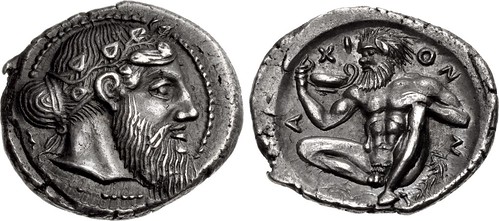
Lot 130–SICILY, Naxos. Circa 461-430 BC. AR Drachm (19mm, 4.32 g, 7h). Bearded head of Dionysos right, wearing tainia decorated with an ivy branch / Silenos, nude and bearded, squatting half-left, holding kantharos in right hand and resting his left on his knee, tail behind; N-A-XI-ON around; all within shallow concave circular incuse. Cahn 55.1 (V40/R46) = Gillet 484 = Sartiges 110 = H. Dannenberg, Grundzüge der Munzkunde (1912), pl. I, 7 = J. Friedländer, “Die Erwerbungen des Koniglichen Miinzkabinets vom 1. Januar 1877 bis 31. März 1878.” in ZfN 6 (1879), p. 10 and pl. I (this coin); HGC 2, 990; SNG Lloyd 1151 = Weber 1467; Basel 385; SNG Lockett 841 = Pozzi 508; Jameson 674; de Luynes 1063; McClean 2467; Rizzo pl. XXVIII, 13 (all from the same dies). Superb EF, lovely deep cabinet tone. Among the finest examples of the type, with a choice pedigree. Estimated at $150,000
From the Gasvoda Collection. Ex Triton XIX (5 January 2016), lot 44; Leu 81 (16 May 2001), lot 89; Charles Gillet Collection (1972), 484; Vicomte de Sartiges Collection, 110; Duplicates from the Berlin Königliches Münzkabinett (J. Hirsch XXVI, 24 May 1910), lot 81 (acquired by the museum c. 1874); Arthur Löbbecke Collection.
In the Hirsch sale of the Berlin duplicates, this coin received a rare lengthy note:
Euböische Drachme von wundervollem Uebergangsstil. Cabinettstück ersten Ranges. Avers und Revers einzigartig im Raume stehend. Pracht-exemplar, wohl das schönste der bekannten Exemplare und deshalb von grösster Seltenheit. [Euboean drachm of wonderful transitional style. Choice example of the first order. Obverse and reverse superbly well centered and struck. Magnificent example, probably the finest of the known specimens and therefore of the utmost rarity.]
On the day of the sale, the coin hammered at 2225 DM, an exceptional amount for a drachm, and the same price that the Berlin Museum’s Naxos tetradrachm of Cahn 54 type realized in the same sale.
Located on the eastern shore of Sicily in the shadow of Mt. Aitna, Naxos was the oldest of the Greek colonies on the island, founded in 735 BC by colonists from Chalkis in Euboia and Ionia. According to Thucydides (1.100), Naxos established its own colony by founding Leontini in 730 BC, which was soon followed by the foundation of a second colony, Aitna, later known as Katane. Taking advantage of the fertility of the surrounding volcanic soil of Mt. Aitna, Naxos developed an economy of viticulture, and along with Leontini and Katane became very prosperous. This wealth attracted the attention of Syracuse, which subjugated Naxos in 476 BC, removing its citizens along with those of Katane to Leontini. Upon the death of Hieron in 461 BC, the Naxians were reinstated to their original city, and formed a close alliance with Leontini and Katane. During the first Athenian Expedition in 427 BC, Naxos actively provided support to the Athenians, who had sent a large fleet to support the allies against Syracuse. In 409 BC, Naxos sided with Syracuse against the Carthaginian threat to Sicily, but in 403 BC, the tyrant Dionysios of Syracuse turned against the Naxians, destroying the city and selling the women and children into slavery.
The present issue is composed of multiple denominations in silver, and is dated by Cahn to the first few decades after the refoundation of the city in 461 BC. Some theorize that it was struck upon the refoundation as a celebratory issue, but one wonders whether the city had the resources for such a coinage so soon. It could also have been struck somewhat later, after the city had prospered from its trade ties to Kamarina and Leontini, and could afford the requisite silver for such a large output. The types found on the drachms are the same as that on the famed tetradrachms (Cahn 54), and the styles of both are so close that it is likely they were engraved by the same hand. The obverse features Dionysos, the god of the vine. The reverse is also an allusion to wine and the Dionysiac cult, featuring the satyr Silenos. Half-man, half-goat followers of Dionysos, these satyrs were often depicted in an ithyphallic state as they pursued the god’s female attendants, the maenads. Silenos was the oldest, wisest, and most drunken of the satyrs. According to Euripides’ only surviving satyr-play, the Cyclops, Silenos had been forced to attend to Polyphemos, who dwelled in the region of Mt. Aitna, hence providing another reason for Silenos’ appearance on this coin of Naxos.
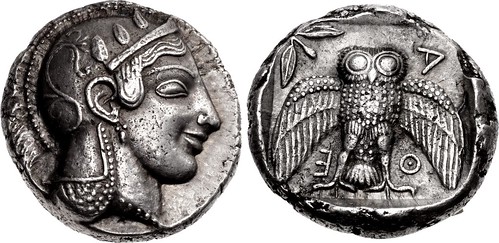
Lot 211–ATTICA, Athens. Circa 469/5-460 BC. AR Dekadrachm (31.5mm, 43.38 g, 3h). Head of Athena right, with frontal eye, wearing single-pendant earring, necklace with pendants, and crested Attic helmet decorated with three olive leaves over the visor and a spiral palmette on the bowl / Owl standing facing, wings spread; olive sprig and crescent to upper left, A-T-E clockwise around from upper right; all within incuse square. Fischer-Bossert, Athenian 24a (O14/R23’) = Stannard & Fischer-Bossert pp. 8–18 (this coin); Starr Group II.C (unlisted dies); Seltman 445–52; HGC 4, 1585; SNG Berry 641; BMC 40 = ACGC 188; Gulbenkian 515 = Jameson 2080; Hirsch 1272; Kraay & Hirmer 357–8; Zhuyuetang 31 (same obv. die). EF, attractive deep gray tone, with iridescence around the devices. Superb metal quality for issue, and perfectly centered strike. Estimated at $500,000
From the Spina Collection. Ex North American Collection of Numismatic Masterpieces (Triton X, 9 January 2007), lot 230.
The present coin represents a splendid example of this magnificent ancient work of art, with a surface quality far exceeding that of the specimens offered over the past several years. It exhibits clear flow lines, very sharp detail junctures, and a crispness often lacking in such large module ancient coins. Additionally, the aesthetic quality of the reverse is exceptional, an extremely powerful design with a well-defined and expressive owl in full glory.
The historical context of the Athenian dekadrachms, as well as concomitant tetradrachms and didrachms of the same class, has been the matter of extended debate. Much of the early confusion stems from a passage in Herodotos, who said that Athens paid ten drachms to each of its citizens for surpluses from the Laurion mines (7.144.1). Although this passage appeared to provide easy historical evidence for the dekadrachm issue, not every scholar was convinced. It was Ernest Beulé who first raised the chronological question of the issue, and from whom all subsequent research stemmed. Taken in context, the passage in Herodotos would place such an issue shortly after the victory at Marathon in 490 BC, a date that was accepted for the dekadrachm issue by prominent early numismatists, Babelon (Traité II, col. 769-770) and Head (HN, pp. 370-371), but which subsequent scholarship has shown to be far too early. Although Gardner retained the 490 BC date of issue in keeping with Babelon (A History of Ancient Coinage, 700-300 BC, p. 162), he added to the discussion by recognizing that the Athenian dekadrachms were contemporary with those of Syracuse, which he identified with the Demareteia mentioned in the ancient sources and dated to the immediate period following the battle of Himera in 480 BC. Seltman, in his major work on the pre-Persian coinage of Athens, rejected Babelon’s conclusions. Yet, he also failed to put credence in the views of Gardner and subsequently placed the issue far too early, in the later 480s BC. Almost immediately, this view came under fire. Robinson saw Salamis as the occasion for issue (NC [1924], pp. 338-340), and Regling, in his revised edition of Sallet’s Die antiken Münzen, viewed the combined victories of Salamis and Plataiai as the occasion. It was Kraay (NC [1956], p. 55; ACGC, pp. 66-68) who, paying attention to the evidence of the hoards, noted that Seltman’s chronology was far too early; yet, he failed to convince his critics. Starr, whose own study of Athenian coinage also relied on the evidence of the hoards, confirmed some of what Kraay had argued, and suggested that the occasion for the issue of the dekadrachms was the battle near the river Eurymedon (circa 469/5 BC). The subsequent discovery of the Asyut Hoard (IGCH 1644) in 1968/9 and the Elmali Hoard (CH VIII, 48) in 1984, confirmed a mid-460s BC date.
Various interpretations of the dekadrachms’ purpose have also been proposed. Although Fischer-Bossert suggests that the size of the issue indicates an economic, rather that ceremonial purpose, Head, much of whose work had formed the basis of dekadrachm scholarship, thought they were special, ceremonial issues struck at various times for "the personal gratification of Tyrants or Kings", and were not part of the actual currency. As seen above, Starr's survey of the Athenian coinage, and his confirmation of Kraay’s earlier conclusions, rejected this earlier conception. It seems clear that such an exceptional and compact issue must have served some special function. Recent scholars have focused on two key historical events during this period that could have produced sizable quantities of silver for this series: the battle of the Eurymedon River in 467 BC, where the resulting captured Persian booty was enormous and was attested to have been distributed (Plutarch, Vit. Cim. 13.6-8), and the capture of Thasos and its mines in 463/2 BC, where the plunder is assumed to have been substantial (Plutarch, op. cit. 14.2).
The dekadrachms stand apart from the typical Athenian coinage not only by their massive size, but the transformation of the reverse type from an owl in profile to one facing the viewer. One cannot fail to notice the power in such a portrayal, which clearly is a representation of the growing Athenian military might that produced the victory over the Persians at the Eurymedon River and the later capture of the bountiful Thasian mines.
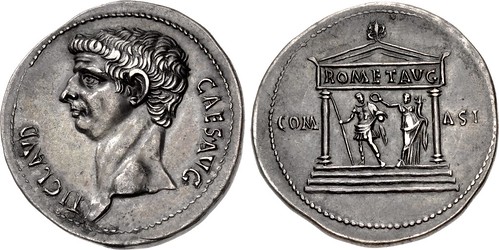
Lot 1014–Claudius. AD 41-54. AR Cistophorus (28mm, 11.47 g, 6h). Ephesus mint. Struck AD 41-42. TI CLAVD CAES · AVG, bare head left / COM ASI across field, distyle temple of Roma and Augustus, enclosing standing facing figures of Claudius, holding scepter, being crowned by Fortuna, holding cornucopia; ROM ET AVG on entablature. RIC I 120 (Pergamum); RPC I 2221; RSC 3; BMCRE 228; BN 304-6. Choice EF, deep cabinet toning. Exceptional portrait coin. Estimated at $20,000
Ex Hess-Divo 307 (7 June 2007), lot 1567; Sternberg XIX (18 November 1987), lot 549.

Lot 1036–Galba. AD 68-69. Æ Sestertius (36mm, 26.89 g, 6h). Rome mint. Struck circa August–October AD 68. IMP · SER · SVLP GALBA · CAES · AVG · TR · P, laureate and draped bust right / LIBERTAS PVBLICA, S C across field, Libertas standing left, holding pileus and vindicta. RIC I 309; ACG dies A116/– (unlisted rev. die): BMCRE 71; BN 147–50. EF, wonderful dark green patina. Bold portrait. Estimated at $30,000
Ex Friend of the Romans Collection (Münzen und Medaillen AG 92, 22 November 2002), lot 46; James Fox Collection (Classical Numismatic Group 40, with Numismatica Ars Classica, 4 December 1996), lot 1408; Beverly Hills Sale (Numismatic Fine Arts XII, 23 March 1983), lot 206; Leu 18 (5 May 1977), lot 304.
Though reigning scarcely seven months, Servius Sulpicius Galba has the honor of inspiring Rome’s portrait artists to reach heights never again equaled or surpassed. Achieving the throne at age 70, Galba was a wizened Roman aristocrat whose sagging, craggy countenance could not have been more different than that of his predecessor, the bloated and dissolute Nero. Indeed, Galba seems to have deliberately promoted himself as a steely martinet who would restore Rome to proper Republican austerity. His coinage pairs his aged, scowling portrait with reverses touting traditional Roman virtues, here depicting Libertas, a concept that embodies both freedom and responsibility. Rome’s mint masters rose brilliantly to the challenge, producing astoundingly lifelike and sculptural portraits such as the present example. But Galba’s austerity program proved to be a major miscalculation, as Rome was not yet ready for such bitter medicine.
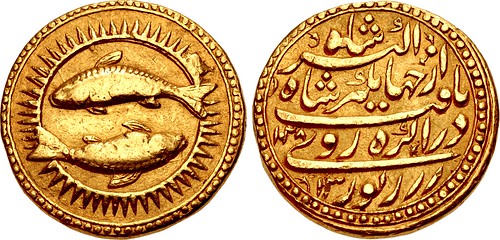
Lot 1259–INDIA, Mughal Empire. Nur al-Din Muhammad Jahangir. AH 1014-1037 / AD 1605-1627. AV Mohur (22mm, 10.83 g, 1 or 7h). Zodiac Type, Class A. Agra mint. Dated [Isfandarmuz] AH 1028 (19 December AD 1618-7 December AD 1619) and RY 13 (15/24 October AD 1617 – 14/23 October AD 1618). Constellation of Mahik/Matsya (Pisces the Fish): tête-bêche pair of carp; radiate sun behind / zar zewar dar Agra ruye yaft az Jahangir Shah Akbar Shah (Received ornament on gold at Agra from Jahangir Shah [son of] Akbar Shah) in Persian verse; RY and AH dates to left. Liddle Type G-111 (same dies as illustration); BM 358; Wright 582; Hull 1407-8; KM 180.20; Friedberg 773. VF, lightly toned, traces of deposits in devices, a few minor field marks. Estimated at $100,000
Previously to this, the rule of the coinage was that on the face of the metal they stamped my name, and on the reverse the name of the place and the year of the reign. At this time it entered my mind that in place of the month they should substitute the figure of the constellation which belonged to that month...in each month that was struck, the figure of the constellation was to be on one face, as if the sun was emerging from it.
The Memoirs of Jahangir [Tuzk-e Jahangiri] (Entry for 20 March 1619)
In the 29th year of his reign, the Mughal emperor Akbar (1556-1605) established the Din-e Ilahi (literally faith of God), a syncretic belief system that incorporated elements of the different religious beliefs in his empire. Immediately thereafter, Akbar began counting his reign in accordance with the tenets this new belief system. Known as the Ilahi Era, dating was now based on a solar, rather than lunar, calendar with the year divided into twelve Ilahi months.
Akbar’s early successors continued to employ this dating system. Jahangir (1605-1628), Akbar’s son and immediate successor, used the Ilahi Era to great artistic effect by issuing two series of mohurs that incorporated Ilahi Era elements. The earliest series, known as the portrait series, since the coins show the emperor on the obverse, all show the constellation Leo superimposed over the sun – a reference to Jahangir’s birth in August. This series was struck within a three-year span early in Jahangir’s reign and are quite rare. The second series, known as the zodiac series, since each of the twelve constellations of the Zodiac is represented on the reverse, was a much larger series. Struck both in gold and silver, the zodiac series was issued from several mints (with Agra being the primary), and like the previous series, minted over three or four years. Since the Ilahi months were solar months and corresponded with the solar ecliptic (an imaginary line in the sky that marks the annual path of the sun), each month was represented by an appropriate sign of the Zodiac, recording its particular month of issue.
Because many of these coins had been recalled and melted by Jahangir’s successor, Shah Jahan, original strikes are very rare. Collector restrikes were periodically issued over the following century, and though they are more often encountered than the originals, are relatively rare themselves. Numismatists have divided the portrait and zodiac series mohurs into four classes:
Class A: Undisputed original strikes, characterized by deep relief, somewhat uneven flans, and rounded calligraphy.
Class B: Possibly original strikes, but more likely minted in the first decade or two following Jahangir’s death. The relief is shallower, of a more uniform appearance, and the calligraphy is more square.
Class C: Mohurs of Class A or B that have had the zodiac type removed and re-engraved.
Class D: Later imitations and forgeries.
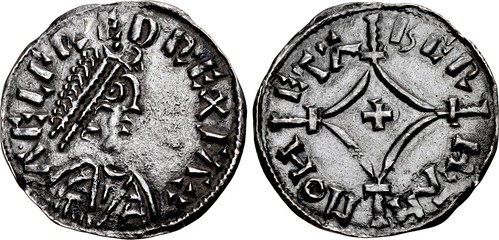
Lot 1368–ANGLO-SAXON, Kings of Wessex. Alfred the Great. 871-899. AR Penny (19mm, 1.30 g, 12h). Cross-and-Lozenge type (BMC v). Uncertain mint; Beorheah(?), moneyer. Struck circa 877-880s. ?ELFRED REX S?X, diademed bust right / BER HAH MOH ET?, cross pattée within lozenge over long beaded cross; crossbars at lozenge ends. Blackburn & Keynes Canterbury B style (moneyer unrecorded); SCBI –; BMC –; North 629; SCBC 1058. Near EF, darkly toned. Unrecorded moneyer for issue. Extremely rare. Estimated at $20,000
Ex Classical Numismatic Group 87 (18 May 2011), lot 2074.
Our understanding of the cross and lozenge coinage of Alfred the Great and his contemporary Ceolwulf II of Mercia has been transformed by the discovery of the Wattlington Hoard in 2015. This extremely important hoard of some 200 coins, jewellery and hack silver was acquired by the Ashmolean Museum after a major fund raising campaign. The cross and lozenge coinage is now firmly recognized as a joint issue of the kings of Wessex and Mercia acting in unison under extraordinary circumstances as their territories were ravaged by marauding Viking armies. Though Mercia was unable to withstand the onslaught Alfred held firm and turned the tide against the foreign invaders, laying the foundations for a new, united kingdom of England in the struggle.
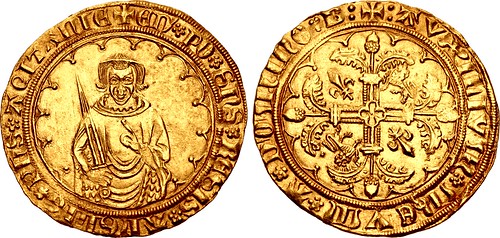
Lot 1406–PLANTAGENET (ANGLO-GALLIC). Edward the Black Prince. As Prince of Aquitaine, 1362-1372. AV Hardi d'or – Guyennois (27mm, 4.01 g, 6h). Bordeaux mint. Struck circa 1368–1371/2. + ЄD’ · PO · GnS · RЄGIS · ΛnGLIЄ · PnS · ΛQITΛNIЄ (rosette stops), half-length figure of Edward facing, wearing plain diadem, holding sword in left hand and pointing at it with his right, within tressure of arches / + : ΛVXILIVm · mЄVm · Λ · DOmInO · B : (rosette stops within), cross quernée, with quatrefoil at center; leopards and lis alternating in angles; all within tressure of arches. AGC 178, 3/a; Elias 161; Elias Collection 250 var. (obv. legend); Schneider 60 var. (same); Duplessy, Féodales 1122; Poey d'Avant 2940; SCBC 8128. In NGC encapsulation, 4833043-001, graded MS 64. Superb portrait. Rare. Estimated at $15,000
Humphrey Sutherland praised the restraint and foresight of the unknown master who designed this type, who "in age when sumptuous decoration of all redundant space was the normal fashion, was content - and dared - to leave the field totally devoid of ornament within its encircling tressure. By this means he concentrated upon this larger and more personal portrait, so lifelike in its almost voluptuous forms, an emphasis which the Italian artists themselves were only just beginning to estimate and enjoy.” Art In Coinage, p. 154.
THE BOOK BAZARRE
HERITAGE 2018 NYINC WORLD COINS SALE SELECTIONS
Here are some lots that caught my eye in the upcoming January 2018 NYINC Heritage World Coins sale. -Editor
Lot 30193: 1808 Ceylon 96 Stivers
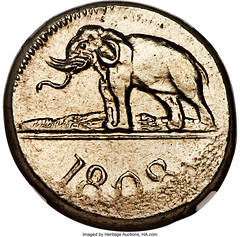
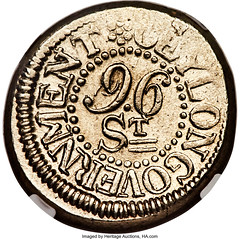
British Colony 96 Stivers 1808 MS62 NGC, KM79, Cr-33. As the largest issue of this design type, the series is often found moderately or heavily worn, and so encountering an example in Mint State is truly a rare thing. This specimen shows some striking weakness near the peripheries, but is otherwise an enviable offering with well-defined central devices and original bright luster. The finest example certified across both PCGS and NGC!
Elephant coins are popular. Great example. -Editor
To read the complete lot description, see:
Ceylon: British Colony 96 Stivers 1808
(https://coins.ha.com/itm/ceylon/british-colony-96-stivers-1808-ms62-ngc-/a/3071-30193.s)
Lot 30333: 1813 Essequibo & Demerary British Colony Stiver
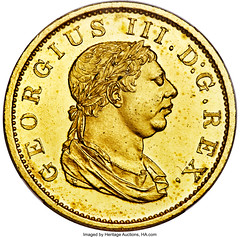
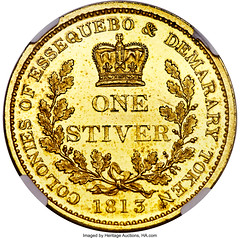
British Colony. George III gilt copper Proof Stiver 1813 PR63 Cameo NGC, London mint, KM10a, Prid-29B. A very scarce colonial issue with a glowing bust of George III showing virtually unbroken frost. Detail is full throughout, which in conjunction with the raised rims attests to the quality of the proof strike.
I'd never heard of this colony before, let alone see a gold coin from there. -Editor
To read the complete lot description, see:
Essequibo & Demerary: British
Colony. George III gilt copper Proof Stiver 1813
(https://coins.ha.com/itm/essequibo-and-demerary/british-colony-george-iii-gilt-copper-proof-stiver-1813-pr63-cameo-ngc-/a/3071-30333.s)
Lot 30420: French Republic La Rochelle Savings Bank Jeton
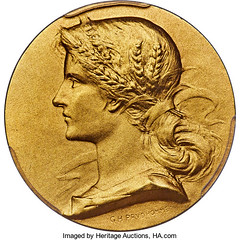
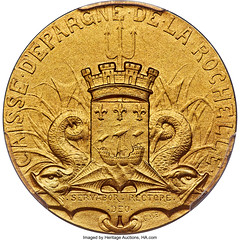
Republic gold Matte Specimen "La Rochelle Savings Bank" Jeton ND (1903) SP69 PCGS, Jacqmin-81a. 18.18gm. A superb bank jeton which is, for all intents and purposes, as-struck. The main devices are in high relief, with intentionally softer legends drawing the eyes toward the centers. The reverse features the crowned arms of La Rochelle, flanked by oceanic motifs.
I've never seen this piece, either. Very nice. -Editor
To read the complete lot description, see:
France: Republic gold Matte Specimen
"La Rochelle Savings Bank" Jeton ND (1903)
(https://coins.ha.com/itm/france/republic-gold-matte-specimen-la-rochelle-savings-bank-jeton-nd-1903-sp69-pcgs-/a/3071-30420.s)
Lot 30423: Gabon Rhinoceros Token
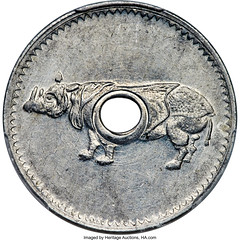
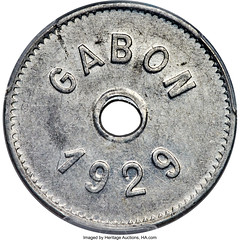
French Equatorial African Territory "Rhinoceros" Non-denominated Token (Franc) 1929 AU55 PCGS, KM-Tn5, Lec-21. Quite rare and purportedly one of only two known, this PCGS designated token has actually been noted as a Franc likely produced for tax reparations but never utilized. This wildlife series was to run for 5 years (1925-1929), each year depicting a corresponding beast.
Anyone can collect elephant coins, but I would suppose rhino tokens are pretty hard to come by. -Editor
To read the complete lot description, see:
Gabon: French Equatorial
African Territory "Rhinoceros" Non-denominated Token (Franc) 1929
(https://coins.ha.com/itm/gabon/gabon-french-equatorial-african-territory-rhinoceros-non-denominated-token-franc-1929-au55-pcgs-/a/3071-30423.s)
Lot 30469: Landau Siege Klippe
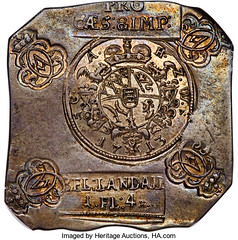
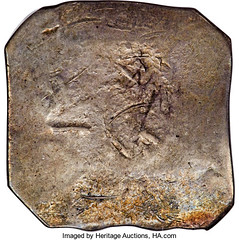
Landau. Free City Siege Klippe 1 Florin & 4 Kreuzer 1713 MS62 NGC , KM12. A fully original klippe issue struck on an evenly toned planchet expressing strong detail, with touches of blue and gold throughout the fields. Produced during the time in which Landau was besieged by the French under the command of the Duc de Villars
Great example of a popular siege piece. -Editor
To read the complete lot description, see:
German States: Landau. Free City Siege Klippe 1
Florin & 4 Kreuzer 1713 (https://coins.ha.com/itm/german-states/landau-free-city-siege-klippe-1-florin-and-4-kreuzer-1713-ms62-ngc-/a/3071-30469.s)

NUMISMATIC NUGGETS: DECEMBER 9, 2018
Here's a selection of interesting or unusual items I came across in the marketplace this week. Tell us what you think of some of these. -Editor
Gold Mystery Object
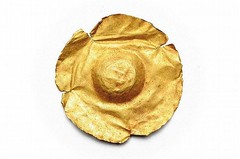
QUICK QUIZ: what is this gold mystery object? -Editor
Acts of Parliament on Counterfeiting of Tokens
 COUNTERFEITING OF TOKENS ACTS, 1805-1813. An interesting selection of 5 original Acts of Parliament.
COUNTERFEITING OF TOKENS ACTS, 1805-1813. An interesting selection of 5 original Acts of Parliament.
Complete original printed acts, disbound from the annual volumes for the various years. A pdf file of the full list of the acts in this collection is available on request.
Great for bibliophiles and researchers. -Editor
To read the complete lot description, see:
COUNTERFEITING OF TOKENS ACTS, 1805-1813. An interesting selection of 5 original Acts of Parliament.
(https://www.abebooks.com/servlet/BookDetailsPL?bi=30163299958)
Wealth of the South Token
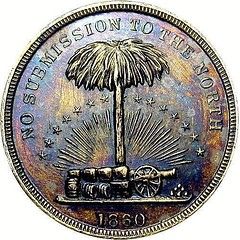
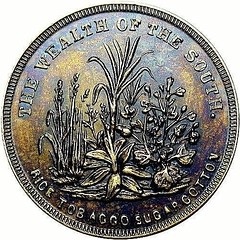
Civil War token Fuld 511/514 b R5 Dewitt JCB 1860-7 John Breckenridge. Raw AU+ sharply struck with nice toning. The Wealth of the South Rice Tobacco Sugar & Cotton No Submission to the North 1860. With view of agricultural products and cannon under Palmetto tree
I saw this token in the eBay stock of E-Sylum supporter Steve Hayden. Dealers! Put me on your mailing lists. -Editor
To read the complete lot description, see:
Wealth Of The South No Submission To The North Patriotic
Civil War Token (https://www.ebay.com/itm/Wealth-Of-The-South-No-Submission-To-The-North-Patriotic-Civil-War-Token/382650958227)
J.L. Blanchot "United Front" Medal
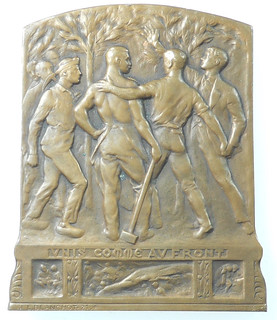
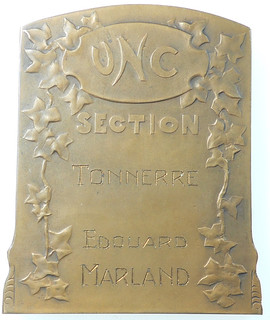
France UNIS COMME AU FRONT by J.L. Blanchot bronze 56mm x 68mm
I noticed this "United Front" medal is on the eBay stock of E-Sylum supporter Hedley Betts. -Editor
To read the complete lot description, see:
France UNIS COMME AU FRONT by J.L. Blanchot bronze 56mm x 68mm
(https://www.ebay.com/itm/France-UNIS-COMME-AU-FRONT-by-J-L-Blanchot-bronze-56mm-x-68mm/163073138764)
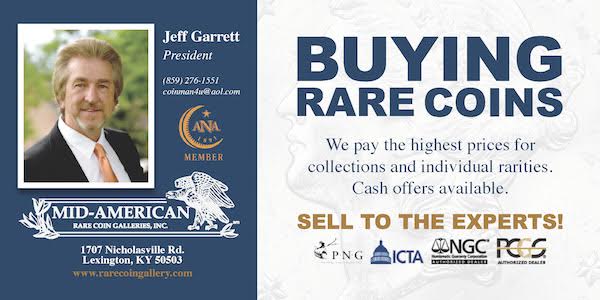
11TH CENTURY CAESAREA GOLD COIN HOARD
Arthur Shippee forwarded this Jerusalem Post article about a new find of gold coins in the Israeli town of Caesarea. Thanks. -Editor
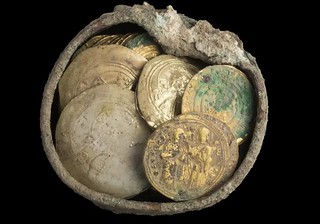 A cache of rare gold coins and a 900-year-old gold earring were discovered at the port of Caesarea. The lucky find during an excavation is said to be evidence of the
Crusaders’ conquest of the port city.
A cache of rare gold coins and a 900-year-old gold earring were discovered at the port of Caesarea. The lucky find during an excavation is said to be evidence of the
Crusaders’ conquest of the port city.
A small bronze pot was found a few days ago at the Caesarea National Park, and inside it were 24 gold coins and a gold earring, according to the Antiquities Authority. The cache was found hidden between two stones in the side of a wall, located in a house in a neighborhood that dated from the Abbasid and Fatimid periods (909-1171 CE).
The coins are dated to the end of the 11th century, which would link the cache to the Crusader conquest of the city in the year 1101, one of the more critical events in the city’s medieval history.
According to the Antiquities Authority, most inhabitants of the city were massacred by Baldwin I’s army between 1100 to 1118 CE. Baldwin I served as the king of the Crusader kingdom of Jerusalem. The authority said it can be presumed that the treasure’s owner and his family likely died in the massacre or were sold into slavery. They would have been unable to return to the site of the cache and retrieve their hidden gold.
“The cache is of a unique combination of coins not yet seen in Israel consisting of two types of coins: 18 Fatimid dinars, well known from previous excavations in Caesarea, where it was the standard local currency of the time,” said Dr. Robert Kool, coin expert at the authority. “And a small and extremely rare group of six Byzantine imperial gold coins. Five of the coins are concave and belong to the reign of the Byzantine Emperor Michael VII Doukas (1071-1079 CE).”
Kool said that the coins did not circulate locally and may hint at trade relations between Caesarea and Constantinople during the time. One coin would be equal to a farmer’s annual salary, so whoever owned the cache was likely wealthy or involved in trade, Kool said.
To read the complete article, see:
CACHE OF GOLD COINS AND 900-YEAR-OLD GOLD EARRING FOUND IN
CAESAREA (https://www.jpost.com/Israel-News/Cache-of-gold-coins-and-900-year-old-gold-earring-found-in-Caesarea-573401)
Here's an MSN News article with some more images. -Editor


To read the complete article, see:
900-year-old gold coins found in Israel
(https://www.msn.com/en-us/news/world/900-year-old-gold-coins-found-in-israel/ar-BBQqVuN)
David Pickup forwarded a BBC News story. Thanks. This one shows an investigator using a book to attribute one of the coins. -Editor
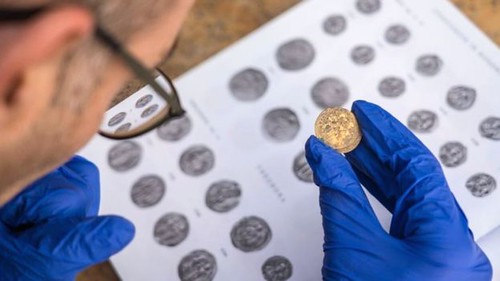
To read the complete article, see:
Rare gold coins found in Israeli city of Caesarea (https://www.bbc.com/news/world-middle-east-46429990)
There are several more images in this article David forwarded from The Times of Israel. -Editor

To read the complete article, see:
Trove of 11th century gold coins discovered in ancient Caesarea
(https://www.timesofisrael.com/trove-of-11th-century-gelt-discovered-in-ancient-caesarea/)
Dick Hanscom forwarded this one from the Daily Mail. Thanks. -Editor
To read the complete lot description, see:
Pot of gold coins and a single earring hidden from the Crusaders behind the
wall of a well 900 years ago found intact in ancient Israeli home (ttps://www.dailymail.co.uk/sciencetech/article-6455659/900-year-old-gold-coins-Israel.html)
Katie de Silva writes:
This one was exciting to me because I worked at Caesarea in the summer of 1978 and we often came upon coins (copper) in our excavations. The site was Herod the Great's capital in Palestine, grew very large in Byzantine times (pop almost 100,000 - huge for the Levant), and there is a crusader fortress still standing on the site. The fort had been converted to a restaurant with an outdoor cabana-type eating area where you could sit in a cooling sea breeze, sipping cocktails watching the sun set over the Mediterranean.
I am happy to see excavations are still going on there, and finds are still happening. An incredibly rich site.

THE 1868/6 AUSTRALIAN OVERDATE SOVEREIGN
This press release from PCGS describes an interesting Australian overdate. -Editor
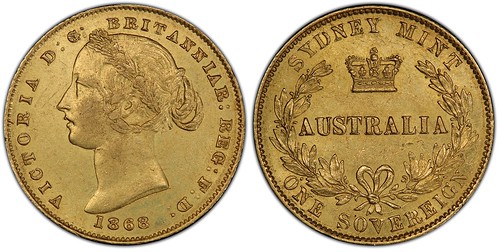
Professional Coin Grading Service (www.PCGS.com) has authenticated the first known 1868/6 overdate Australian sovereign.
The historic gold coin depicting a young Queen Victoria recently was submitted by a sharp-eyed professional numismatist on the Australian island state of Tasmania, and it now is certified PCGS AU58+.
“The sovereigns from 1855 to 1870 are among the most important and valuable series in Australian numismatics. These were the first coins struck by the Royal Mint in Sydney that was established in 1855 as the first branch of the British Royal Mint,” said Scott Thompson, PCGS World Coin Department Manager.
“These sovereigns have a distinctive ‘Sydney Mint’ reverse. This is the only time the Royal Mint permitted a design unique to a branch mint,” explained Thompson.
John Haddad, Managing Director of Tasmanian Numismatics in Moonah, Tasmania, recently submitted the coin to PCGS. He obtained it six months earlier from England, and when PCGS confirmed it is a previously unknown overdate Haddad said he “was filled with joy, so happy, fist pumping and over the moon!”
“I have a keen eye for varieties and I enjoy finding and studying them. This particular coin was advertised at the time as being an 1868/6 overdate, although it was not formally recognized as such. I was skeptical at first but after enlarging images of the coin I could clearly see the overdate. I had to have it with intentions of having this variety authenticated by PCGS,” Haddad explained.
“Since obtaining the coin I have researched images for this variety from past sales going back 30 years and have not seen another. There may be others out there but as I have not seen another, it may be the only example in existence,” he stated.
The coin has been consigned to Heritage Auctions and it will be offered on January 6, 2019 in their New York International Numismatic Convention World Coins Signature Auction.
How did the overdate occur at the Sydney Mint?
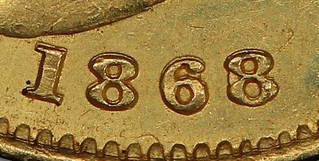 “Logistically, getting supplies and skilled labor was challenging for the branch mints in the 1800s. Reworking dies and creating overdates was a practical solution for
getting around the difficulty of obtaining new dies from the Royal Mint in England. Only a handful of overdates in the Australia sovereign series are known, and of those seen in
person by PCGS experts, this 1868/6 is the most pronounced with a good portion of the 6 still visible underneath the 8,” said Thompson.
“Logistically, getting supplies and skilled labor was challenging for the branch mints in the 1800s. Reworking dies and creating overdates was a practical solution for
getting around the difficulty of obtaining new dies from the Royal Mint in England. Only a handful of overdates in the Australia sovereign series are known, and of those seen in
person by PCGS experts, this 1868/6 is the most pronounced with a good portion of the 6 still visible underneath the 8,” said Thompson.
Other overdate examples of the Australian Reverse sovereigns PCGS has graded are: 1861/0, 1865/4, 1865 6/5. There are some other combinations listed in numismatic publications, but not yet confirmed by PCGS.
“In a series that is already rare, these overdates are in a category all their own. Many examples known today are unique, such as the 1868/6,” Thompson stated.
MAN CLEARED OVER IMPORTING SCRAP EUROS
Phil Mernick forwarded this interesting BBC News story about a man who bought Euro coins for scrap in China. -Editor
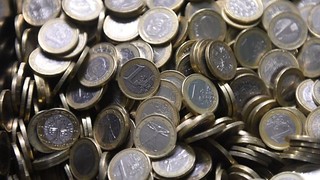 A German man arrested in Austria for alleged fraud after trying to convert thousands of old and damaged euro coins imported from China has been acquitted.
A German man arrested in Austria for alleged fraud after trying to convert thousands of old and damaged euro coins imported from China has been acquitted.
The €1 and €2 coins were collected from scrapped cars and washing machines sent to China from Western countries.
The man, in his 40s, was detained in Austria earlier this year after police found 117kg (257lb) of the coins, worth €15,000 ($17,000; €13,000), in his car.
However an Austrian court has now ruled that his actions were not illegal.
The accused, referred to only as Mr H, had explained how he frequently travelled to China with cash to procure the coins, which he said were found in scrap metal items sent there to be destroyed.
He said that because the euro coins were not used as currency in China, he could purchase large quantities by weight at a fraction of their value and return to convert them for notes at Austrian banks using coin-counting machines.
His lawyer, Christoph Eberle, had maintained that the coins were not counterfeit, and that importing and converting the genuine old and damaged coins did not breach any Austrian law.
To read the complete article, see:
Austria clears German who imported damaged euros from China (https://www.bbc.com/news/world-europe-46453983)
Earlier articles described a similar situation where U.S. coins were being bought for scrap and returned through a U.S. Mint program. There were accusations that the coins were counterfeit and that there was no was so many genuine coins could be found in scrap.
A few months ago I decided to sell my old car. So I emptied out all my stuff and double-checked every nook and cranny in the passenger compartment. I was stunned by the number of coins I found - a dozen or so that I'd completely missed on the first go-round. So I think the story is at least plausible. -Editor
To read the earlier E-Sylum article, see:
U.S. MINT RESUMES MUTILATED COIN PROGRAM (https://www.coinbooks.org/v21/esylum_v21n05a32.html)

NEW RESEARCH ON THE SAUDI ARABIA GOLD DISCS
Economics blogger JP Koning submitted a new research piece on the 1945 and 1947 U.S. Mint gold discs. Thank you! He originally published it as a guest blog piece on Bullionstar. Here's an excerpt- see the complete article linked below. -Editor
I stumbled on some strange gold discs earlier this year. They’re pictured below:
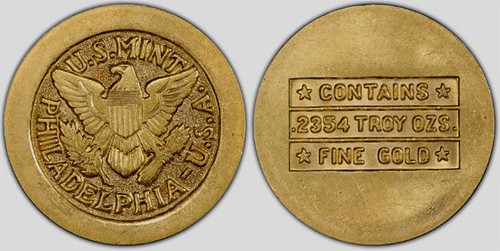
As you can see, the front of the gold disc has been stamped with the emblem of the U.S. Mint, specifically that of the Philadelphia mint. On the reverse side, contains details about weight and purity. But while they are shaped like a typical coin, the discs are curiously anonymous. Unlike a typical coin they have no date, denomination, issuing country, or the face of some dead President or royal. What are these odd discs and why were they produced? They’re pictured below:
The ARAMCO connection
A quick Google search reveals all sorts of websites that sell the gold discs. APMEX, one of the world’s largest online precious metals dealer, thusly:
“This Gold disk was made by the U.S. Mint in Philadelphia for ARAMCO (Arabian American Oil Company). ARAMCO needed them to pay royalties to Saudi Arabia for the right to start drilling for the vast oil reserves known to be there, and to help alleviate the shortage caused by the record consumption during World War II.”
The reference to ARAMCO immediately jumps out. This is one of the most provocative and persistent details of the discs’ mythology: that they were produced for the Arabian American Oil Company, or ARAMCO, in the 1940s so that it could pay the Saudi government for oil. Comprised of a consortium of U.S. oil companies that included Standard Oil of California, Texaco, Exxon, and Mobil, ARAMCO explored and developed oilfields in Saudi Arabia.
The association of these disks with ARAMCO pops up everywhere on the internet. Heritage Auctions, the world’s largest collectible auctioneer, declares to discs to be “Aramco gold.” The Deutsche Bundesbank, Germany’s central bank, recently added the discs to its 90,000 coin collection. It describes them as being struck by the U.S. Mint on “behalf of the Arabian American Oil Company.”
Boosel’s pet theory
The linkage of the discs to ARAMCO was first proposed in 1959 by numismatist Harry X. Boosel. Boosel’s curiosity was originally sparked when he bought one of the discs in
1954. He compiled a list of questions about the disc’s origins and diligently sent out letters to the U.S. Mint, the Saudi Arabian embassy, the State Department, and more.
After he received several responses, Boosel penned a detailed article on the discs’ origins that was published in 1959 in The Numismatist, a publication by the American
Numismatic Association.
Boosel learnt that the Philadelphia Mint had produced two types of discs. A larger one in 1945 contained 0.942 oz of gold, while the smaller 1947 version contained a quarter of that, 0.2354 ounces. The Mint had produced 91,210 of the original 1945 issue and 121,364 in the second batch.
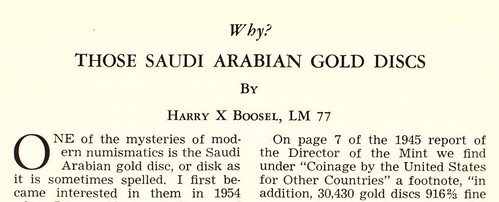
The letters that Boosel received in response to his inquiries further indicated that the order had been filled by the U.S. Mint on behalf of the Saudi government. The gold had been purchased by the Saudis from the U.S. Treasury by converting U.S. dollars into gold at the statutory $35 rate. This was back when the U.S. was still on a gold standard and the gold window was still open. The gold in their possession, the Saudis had then asked the U.S. Mint to turn it into discs. This wasn’t the first order that the Mint had completed for Saudi Arabia, one of Boosel’s correspondents pointed out. It had previously produced silver riyal coins as well as copper “girshs”.
But Boosel was annoyed. Although he had managed to fill in much of the detail surrounding the mysterious Saudi gold discs, he still didn’t know why they had been commissioned. His frustration was such that he concluded the paper by supplying his own pet theory, that the U.S. Mint had produced the discs for ARAMCO. Boosel tells us that gold was in short supply during and after the war, so it traded at a large–almost double!–premium to its official price of $35. Which is true. ARAMCO didn’t want to pay such a high price for gold, he claims, and thus went to Uncle Sam to get discs. Boosel provided no documents to back his contention.
Boosel’s shot-in-the dark ARAMCO theory has since gone on to become part of the accepted canon surrounding the discs. A 1991 New York Times article about the discs, for instance, notes that:
“Aramco sought help from the United States Government. Faced with the prospect of either a cutoff of substantial amounts of Middle Eastern oil or a huge increase in the price of Saudi crude, the Government minted 91,120 large gold disks adorned with the American eagle and the words “U.S. Mint — Philadelphia.” Aramco paid for the minting and the bullion. The coins were shipped off to Saudi Arabia.”
By the 2000s, coin retailing websites were eagerly repeating Boosel’s ARAMCO theory. Can you blame them? A tie-in with the oil industry spices up the discs’ history. And a provocative mythology can boost their market price. Although a 1945 disc contains just under an ounce of gold, it sells for US$2,749 on APMEX. A regular gold coin that contains one ounce of gold, say an American Eagle, currently retails for around US$1250. The market evidently attaches a very large premium to the rarity and unique history of the Saudi gold discs.
New documents surface
The ARAMCO story is certainly plausible, but I don’t think it is factual. The Federal Reserve Archival System for Economic Research, or FRASER, a relatively new
archive, houses several documents that shed light on the discs, including a number of classified discussions between officials from the Federal Reserve and the U.S. Treasury about
the gold market between the end of the war up till 1950. This information would not have been available to Boosel when he was doing his research.
Boosel is certainly correct that ARAMCO needed gold to pay for oil. When the Saudi monarch Ibn Saud and ARAMCO inked their deal in 1933, the terms of the deal stipulated that for each ton of oil produced, ARAMCO owed the Saudi government a royalty of four gold shillings. This amount was payable in gold sovereigns, a British coin that circulated widely in the Middle East at the time. Each sovereign contained 0.2354 ounces of gold.

1893 British Gold Sovereign
The sovereign, however, had been discontinued. For the most part, the Brits had stopped making these coins by 1917, and so their supply was limited. The FRASER documents provide
us with several snapshots of ARAMCO desperately negotiating for old gold sovereigns. In 1948, it approached the Central Bank of Argentina with an offer to buy up its inventory of
sovereigns while 1950 finds it knocking on the doors of the South African government to do the same.
It seems logical, therefore, that in light of the rarity of sovereigns, ARAMCO might have contracted with the U.S. Treasury for gold discs. That the discs were stand-ins for sovereigns is underlined by the fact that the Philadelphia Mint had produced the 1947 issue with the exact same specifications as a British sovereign.3 Both sovereigns and discs contained 0.2354 ounces of gold and were of a fineness or purity of 0.9167.
Despite the attractiveness of Boosel’s ARAMCO theory, the FRASER documents do not bear it out. In each instance where discussions about the discs occur, they specify that the discs were made for the Saudi government, not ARAMCO.
Boosel’s ARAMCO theory is even more unlikely given that the transaction would have been illegal. Under the rules governing the gold standard of the day, the Treasury was prohibited from selling gold to private companies. When the U.S. had gone back on the gold standard in 1934 after a hiatus beginning in 1933, the terms of redemption had been altered. Whereas everyone had historically had the right to convert U.S. dollars into gold, after 1934 only foreign governments were permitted to convert dollars into the yellow metal. Additionally, all U.S. gold coins were demonetized and private ownership of gold declared illegal.
So ARAMCO didn’t have the right to purchase gold from the Treasury. Not only that, but it would have been illegal for ARAMCO to store the discs on U.S. territory once received.
In Conclusion
The ARAMCO gold disc story is apocryphal, a bit of idle speculation first dreamt up fifty years ago and recounted often enough to be accepted as gospel. If anything,
The story of the Saudi gold discs also illustrates the bewildering variety of monetary arrangements that have existed across the globe, even within the same era. How strange is it that the U.S., which itself had banned gold coins only a few years before, found itself in the position of minting gold coins for a nation that was still wholly dependent on precious metals? Monetary systems are often full of surprises like this.
To read the complete article, see:
Why the US Mint once issued gold discs to Saudi Arabia
(https://www.bullionstar.com/blogs/jp-koning/why-us-mint-once-issued-gold-discs-saudi-arabia/)
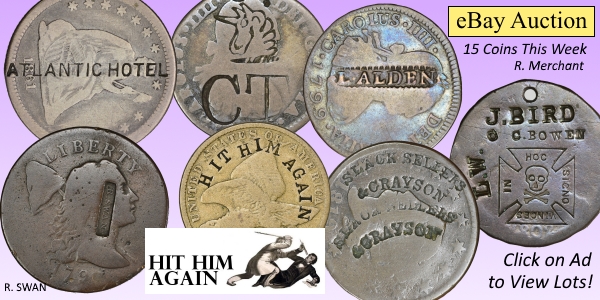
THE CAMERON HOUSE THEORY
I was pleased to discover that economics blogger JP Koning had referenced a recent E-Sylum item about Civil War redenominated U.S. coinage. That was my favorite article from that issue, which had a number of strong candidates. Thanks again to Bill Groom and Bob Merchant for their contributions. It's great to see our efforts fueling further discussion and research. Here's an excerpt from JP's blog post, which includes his earlier tweet of our image. -Editor
The idea that coins circulated at more than their precious metals content, or intrinsic value, can be found throughout Mitchell-Innes's two essays. He uses the existence of this premium as proof that the metal content of a coin is not relevant to its value, its credit value being the sole remaining explanation.
To some extent, I agree with Mitchell-Innes. Over the course of history coins have often circulated above their intrinsic value, and from time-to-time this premium has been due to their value as credit. The merchants' counterstamps below are great examples. By adding a stamp to a government coin, these merchants have elevated the coin's value from one cent to five or ten cents.

These three coins are straight out of Mitchell-Innes two essays. As I say in the tweet, counterstamped coins effectively functioned as an IOU of the merchant. For instance, take the five cent Cameron House token, on the right. This token was issued by a Pennsylvania-based hotel—Cameron House. Its intrinsic value was one cent, but Cameron House's owner promised to take the coin back at five cents, presumably in payment for a room. The sole driver of the coin's value was the reliability of Cameron House's promise, the amount of metal in the token having no bearing whatsoever on its purchasing power.
While Cameron House's stamp turned metal into a much more valuable form of credit, not all stamps do this. Last week I wrote about coin regulators who regulated gold coins and shroffs who chopped coins. Both functioned as assayers, weighing a coin and determining its fineness. If the coin was up to standard, the regulator or shroff stamped their brand onto its face and pushed it back into circulation. Below is a chopmarked U.S. trade dollar:

Actually, this is of course a regular U.S. Morgan silver dollar, not a Trade Dollar. But the reasoning is valid nonetheless. -Editor
But unlike the Cameron House stamp, the regulation or chopping of coins didn't turn them into a credit of the regulator or shroff. The marks were simply indicators that the coin had been audited and had passed the test, and nothing more.
Both the Cameron House coin and the chopped U.S. trade dollar would have traded at a premium to the intrinsic value of the metal that each contained. But for different reasons. As I wrote above, the Cameron House coin was a form of credit, like a paper IOU, and thus its value derived from Cameron House's credit quality, not the material in the token. But not so the chopped U.S. trade dollar. Precious metals are always more useful in assayed form than as raw bullion. While it is simple to test the weight of a quantity of precious metals, it is much harder to verify its fineness. This is why chopmarks would have been helpful. Anyone coming into possession of the chopmarked coin could be sure that its fineness had been validated by an expert shroff. And thus it was more trustworthy than silver that had no chopmark. People would have been willing to pay a bit extra, a premium, for this guarantee.
Remember that a decline in the amount of metal in a five-cent Cameron House token would not have changed its purchasing power. With a chopmarked trade dollar, however, any reduction in its metal content flowed through directly to its exchange value. This is because a chopmarked dollar was nothing more than verified raw silver. And just as the value of raw gold or silver is determined by how many grams are being exchanged, the same goes for a chopmarked trade dollar.
And so whereas Mitchell-Innes has a single theory of money, we've arrived at two reasons for why coins might trade at a premium to intrinsic value, and why their purchasing power might change over time. The Cameron House theory, which also happens to be Mitchell-Innes's theory, and the chopmarked trade dollar theory, which is completely contrary to Mitchell-Innes's essays.
I've used private coinage for my examples, but these principles apply just as well to government coinage. Our modern government-issued coins are very similar to the Cameron House tokens. They are a type of IOU (as I wrote here). In the same way that trimming away 10% from the edge of a $5 note won't reduce that note's purchasing power one bit, clipping some of the metal off of a toonie (a $2 Canadian coin) won't alter its market value. The metal content of a modern coin is (almost always) irrelevant.
But whereas modern government coins operate on Cameron House principals, medieval government coins operated on the same principals as chopmarked traded dollars. In England, a merchant who wanted coins would bring raw gold or silver to a mint to be converted into coin. But the merchant had to pay the mint master a fee. The amount by which a coin's market value exceeded its intrinsic value depended on the size of the mint's fee.
Say it was possible for a merchant to purchase a certain amount of raw gold with gold coins, pay the fee to have the raw gold minted into coins, and end up with more coins than he started with. This would be a risk-free way to make money. Everyone would replicate this transaction—buying raw gold with coins and converting it back into coins—until the gap between the market price of a coin and the market price of an equivalent amount of gold had narrowed to the size of the fee.
Premia on coins weren't always directly related to mintage fees. English mints usually operated on the principle of free coinage—anyone could bring their gold or silver to the mint to be turned into coin. But sometimes the mint would close to new business. Due to their usefulness and growing scarcity, gold coins would circulate at an ever larger premium to an equivalent amount of raw gold. Since merchants could no longer bring raw gold to the mint and thereby increase the supply of coins, there was no mechanism for reducing this premium.
So as you can see, whether the mint was open and coinage free, or whether it was closed, the premium had nothing to do with the coin's status as a form of credit. It was due to a combination of the superiority of gold in validated form and the availability of validated supply.
In sum, Mitchell-Innes is certainly right that coins have often been a form of credit. A stamp on a piece of metal often elevates it from being a mere commodity to a token of indebtedness. In which case we get Cameron House money. But as often as not, that stamp is little more than an assay mark, a guarantee of fineness. In which case we have chopmarked trade dollars. Both sorts of stamps put a premium on the coin, but for different reasons.
To read the complete article, see:
The credit theory of money
(http://jpkoning.blogspot.com/2018/11/the-credit-theory-of-money.html)
To read the earlier E-Sylum article, see:
CIVIL WAR REDENOMINATED U.S. COINAGE (https://www.coinbooks.org/v21/esylum_v21n43a14.html)

LAND LIMITATION, HIT HIM AGAIN COUNTERSTAMPS
Speaking of counterstamps, there are a couple interesting political items in Bob Merchant's current eBay sale worthy of further research. -Editor
LAND LIMITATION Counterstamp
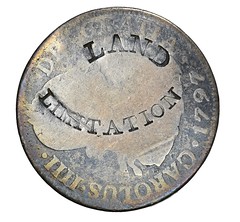
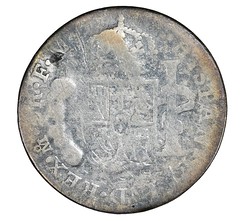
"LAND / LIMITATION"
1797-Mo-FM Two Reales (KM 91)
Stamped in two arcs, could be from a single punch. The other known example of this countermark (on an 1844 Large Cent) has the same odd relationship between the two arcs.
Potentially a very important token - a forgotten U.S. historical event. Issued in the mid-to-late 1840’s? I recall that someone once wrote an article about this counterstamp.
I have seen an antique pamphlet entitled "A SHAKER'S VIEWS ON THE LAND LIMITATION SCHEME AND LAND MONOPOLY, AND MORMON PERSECUTION". It was published by Frederick W. Evans of Mount Lebanon, NY. This may or may not have anything to do with the countermark, but it’s a pointer for further research.
Brunk L-94.
Dave Bowers submitted some information in an April 2001 E-Sylum article, republished below. -Editor
LAND LIMITATION • 1844 cent • Counterstamped by: National Reform Association advocates. • Location: NY, New York City • Category: Political statement. • Stamped: LAND and LIMITATION, each in a curved logotype punch. • F-15 Land Limitation
{Commentary} Issued by advocates of the National Reform Association (NRA), formed by George Henry Evans from the membership of the Locofocos, National Trades Union, and the Workingmen's Party. On March 13, 1844, a meeting of working people, under the name of National Reform Party, was held in New York City at Chatham and Mulberry streets. A committee was appointed to investigate "a depression of labor, and a social degradation of the laborer."
The committee filed a report which was accepted at the next meeting. The National Reform Association resolved to use the "land question" as the prime element in its political statements, and laid out three objectives:
1. Homestead legislation by the federal government to allow workers and others to acquire public lands free of charge.
2. Legislation to be enacted by various states to exempt land such as farms from seizure in debt collection.
3. Land limitation (precise wording) to restrict the ownership of large amounts of land by wealthy individuals and other entities, so that land would become more easily available to the general population.
In the following year, 1845, the NRG joined with advocates of the Fourierist movement to schedule the first of a series on annual National Industrial Congresses. It is likely that the National Reform Association was also involved in 1844 with the issuance of the VOTE THE LAND / FREE counterstamps (see listing, which reiterates much of the present commentary and adds more). Similar to the LAND LIMITATION counterstamp, it is known on at least one cent (listed below) and on Spanish-American silver two-reales coins (1797 and 1812 in the present instance).
To read the complete lot description, see:
Rare Counterstamp - Forgotten U.S. History Event - "LAND /
LIMITATION" (https://www.ebay.com/itm/Rare-Counterstamp-Forgotten-U-S-History-Event-LAND-LIMITATION/132882066657)
To read the earlier E-Sylum article, see:
VOTE THE LAND FREE (https://www.coinbooks.org/esylum_v04n16a07.html)
HIT HIM AGAIN Counterstamp
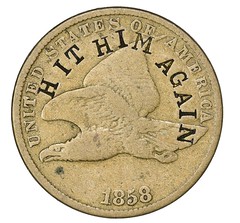

"HIT HIM AGAIN"
1858 U.S. Flying Eagle Cent
This countermark references a very famous historical event in South Carolina history.
"Hit Him Again" are the words inscribed on a cane given by the City of Charleston to Congressman Preston Brooks of South Carolina. The cane was intended to replace the cane that he broke over the back of Charles Sumner in 1856. The famous abolitionist political cartoon was originally done by J.L. Magee, and carried the inscription "Southern Chivalry: Argument vs. Clubs."
Preston Brooks is an entertaining character of American history - despite his being on the wrong side of slavery. During his lifetime, he participated in multiple duels, fisticuffs, was expelled from college (after being suspended twice), held up a jail at gunpoint - only to eventually become a lawyer and U.S. Congressman.
As to his defining event, Brooks assaulted Charles Sumner (Massachusetts senator) in retaliation for the contents of a speech delivered on the floor of the Senate in promotion of Kansas’s entry into the Union as a free state. Brooks took exception to two main points of Sumner’s speech. First, Charles Sumner mocked Senator Butler’s (a relative of Brooks) speech impediment .....
( Search the internet for A LOT MORE INFORMATION on this important historical event !!! )
You can just sense the forthcoming Civil War brewing with this piece ......
Have any other of these coins survived? If you know of one then please tell me. This could be the last survivor!
Brunk H-634.
These look like individually punched letters rather than a logotype punch. That greatly slows the process and limits how many can be made. Has anyone seen another one of these?
A search of the Newman Numismatic Portal found an article written by Greg Brunk in the July/August 2013 NI Bulletin from Numismatics International. -Editor
To read the complete lot description, see:
Rare, Important South Carolina U.S. Political Counterstamp
"HIT HIM AGAIN" !! (https://www.ebay.com/itm/Rare-Important-South-Carolina-U-S-Political-Counterstamp-HIT-HIM-AGAIN/132882065485)
To read the Brunk NI Bulletin article, see:
https://nnp.wustl.edu/library/book/521013?page=6
THE BOOK BAZARRE
DECEMBER 2018 MEDAL SELECTIONS FROM NUMISMAGRAM
Jeremy Bostwick at Numismagram passed along a few highlights from his recent upload of new material to his website. In addition to the items below, look for some attractive WWI-related pieces, an offering of shooting medals, a cool French piece for any racing enthusiast, and many other attractive European art medals. -Editor
1763 Seven Years' War Silver Medal
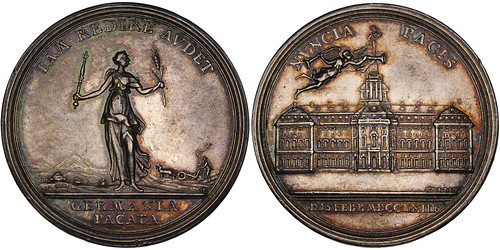
UNITED STATES & GERMANY. Colonial America and Preußen (Prussia) silver Medal. Dated 1763. Commemorating the Treaty of Hubertusburg and the end of the Seven Years' War (French and Indian War in America) (44mm, 21.76 g, 12h). By J. L. Oexlein. IAM REDIRE AVDET (now she dares to return...), Germania standing facing, head right, holding scepter and grain ear; mountains and plowman in background; in two lines in exergue, GERMANIA / PACATA (...with Germany being at peace) / NVNCIA PACIS (the messenger of Peace), view of the Hubertusburg palace; above, Fama (Rumor) flying right, blowing in one trumpet and holding another; D 15 FEBR MDCCLXIII in exergue. Edge: Plain, with a few light marks. Betts 446; Pax in Nummis 595; Olding 931; Henckel 1658. Choice About Uncirculated. Attractive cabinet tone, with a delightful mélange of cobalt and burgundy; tremendous underlying luster. $435
To read the complete item description, see:
https://www.numismagram.com/product-page/100468
1763 Seven Years' War Silver Medal

UNITED STATES & GERMANY. Colonial America and Preußen (Prussia) silver Medal. Dated 1763. Commemorating the Treaty of Hubertusburg and the end of the Seven Years' War (French and Indian War in America) (22mm, 2.72 g, 12h). By D. F. Loos. IAM REDIRE AVDET (now she dares to return...), Germania standing facing, head right, holding scepter and grain ear; above, zodiacal banner with Leo and Virgo; mountains and plowman in background; in two lines in exergue, GERMANIA / PACATA (...with Germany being at peace) / NVNCIA PACIS (the messenger of Peace), view of the Hubertusburg palace; above, Fama (Rumor) flying right, blowing in one trumpet and holding another; D 15 FEBR MDCCLXIII in exergue. Edge: Plain.
Betts 447; Pax in Nummis 596; Olding 930; Henckel 1659. Choice About Uncirculated. Attractive cabinet tone, with some hues of burnt sienna around the devices; majestically lustrous. Compare to the Ford specimen, which realized a hammer of $400 in December 2008 (Stack's [Coin Galleries], lot 1629). $435
Sometimes referred to as 'World War Zero,' given its scale overall number of belligerent powers, the Seven Years' War began primarily with Austria's desire to recover Silesia from the Kingdom of Prussia. Since Great Britain had been aiming to increase her colonial possessions in the new world at the expense of France, the strife in the American theater began to merge with that in Europe, resulting in a legitimate global conflict, with every major European power taking the side of either Great Britain/Prussia or France/Austria. In addition to North America and Europe, skirmishes also played out in Central America, the western coast of Africa, India, and the Philippines. Ultimately, a peace was achieved through the Treaty of Paris, formally ending all conflicts save for the Silesian question; the Treaty of Hubertusburg, signed five days later, ended the issue between Prussia and Austria, formally ending the war.
These two medals, displaying similar designs yet different modules, were included by C. Wyllys Betts in American Colonial History Illustrated by Contemporary Medals due to their relation to the French and Indian War conflict in colonial America.
Great pair of Betts medals. -Editor
To read the complete item description, see:
https://www.numismagram.com/product-page/100514
1926 Fuad I bronze Medal
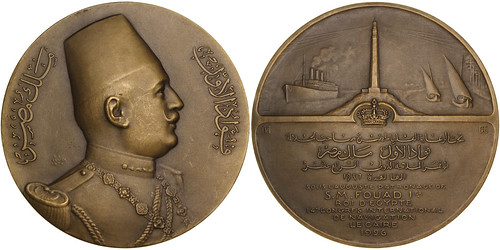
EGYPT & FRANCE. Fuad I bronze Medal. Dated 1926. Commemorating the 14th International Congress of Navigation (72mm, 125.71 g, 12h). By S. E. Vernier in Paris.
Uniformed bust right, wearing fez; Arabic legend around / Vignette containing central lighthouse; steamship to left, small sail boats to right; text below. Edge: «cornucopia» BRONZE.
Cf. Goldberg 78, lot 2994 (which realized a hammer of $1,350 in 2014); cf. Album 24, lot 2225 (which realized a hammer of $1,600 in 2016). Choice Mint State. Sublime yellow-bronze matte surfaces. $1,495
Struck for the Congress of Navigation held in Cairo, this attractive art medal features some of the more iconic features which would have been seen in the Mediterranean: a steam ship, two feluccas, and a lighthouse–an allusion to the famous Pharos of Alexandria (one of the Seven Wonders of the Ancient World).
Nice portrait -Editor
To read the complete item description, see:
https://www.numismagram.com/product-page/100472
1928 Albrecht Dürer Silver Medal
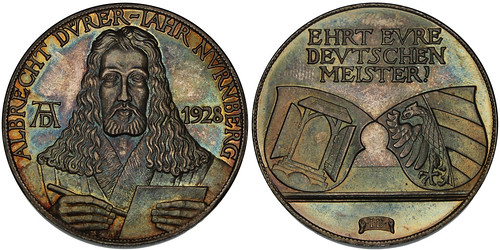
GERMANY. Albrecht Dürer silver Medal. Dated 1928. Commemorating the 400th Anniversary of the Artist's Birth (36mm, 24.97 g, 12h). By J. Bernhart.
ALBRECHT DÜRER–IAHR NÜRNBERG, facing bust, holding tablet and stylis / EHRT EVRE / DEVTSCHEN / MEISTER!, two coats-of-arms set upon platform. Edge: PREUSS. STAATSMÜNZE•SILBER 900 FEIN. Erlanger 994; Erlanger Collection 1553; Mende 126. Gem Proof. Beaming luster, with dazzlingly toned surfaces exhibiting a rich palette of cobalt, sea foam green, and burnt sienna. $165
A prolific painter, printmaker, and humanist during the German Renaissance, Albrecht Dürer garnered quite the reputation while still in his 20's, communicating with many of the leading artists of his time while receiving the patronage of Holy Roman Emperor Maximilian I. One of his most famous works, his Self-Portrait at Twenty Eight, is notable for its allusion to earlier versions of the Christ Pantocrator icon, and is similarly rendered on the obverse of this commemorative medal.
Nice medal - great toning. -Editor
To read the complete item description, see:
https://www.numismagram.com/product-page/100490
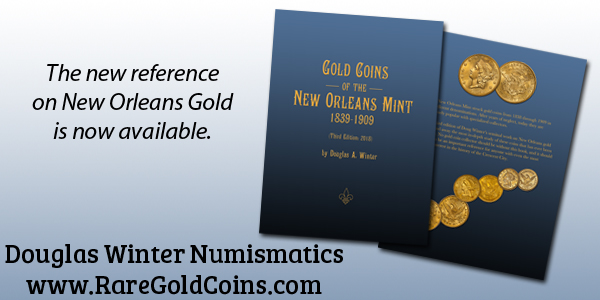
ENDANGERED SPECIES BANKNOTE DESIGN CONCEPTS
As discussed recently, the Bank of England is deciding on a famous scientist to depict on its new £50 note. This article, originally published November 12, 2018, proposes banknote concept designs highlighting endangered species. There are nine nicely done renditions - see the complete article online for more (I didn't care for the Irish Hare). Here are some that caught my eye. Thanks to the December 4, 2018 issue of the Society of Paper Money Collectors' News & Notes for leading us to this one. -Editor
Banknotes are fascinating things – little works of art that pass through our hands each day almost unnoticed. Every so often, there is a news story about a new design, and perhaps some controversy over which historical figure will feature on the front of the note. But what if the Bank of England is getting it all backwards?
It’s fine to celebrate the achievements of the past, but we decided to put a new spin on things by thinking about the future that humankind needs to protect. Our new series of speculative banknote concept designs celebrates not great humans that we’ve lost, but endangered species that we might lose if we don’t put more work, and money, into saving
Welsh coast: Loggerhead Turtle

Turtles once shared the planet with dinosaurs, and each individual might live as long as a human being. But human interference has caused a drastic diminishing of the species over the past six decades.
Loggerhead turtles divide their time between far-flung locations from the coast of Wales to Florida and New Carolina, following the currents and the warm water. Industrial fishing, the development of coastal areas, and climate change all play a part in the reptile’s precarious situation.
Scottish Highlands: Scottish Wildcat
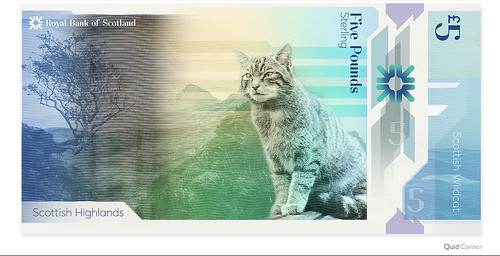
Wildcats are so rare that they have begun interbreeding with domestic or feral cats, which is compromising the genetic lineage of the species. It can also result in the spreading of feline diseases.
They can grow to nearly a metre long and stalk the woods of the Scottish Highlands, where they are sometimes mistaken for ordinary cats by gun-wielding farmers keen to protect their game birds from predators. It’s reckoned there may only be a 100-300 wildcats left.
Moray Firth: Bottlenose Dolphin
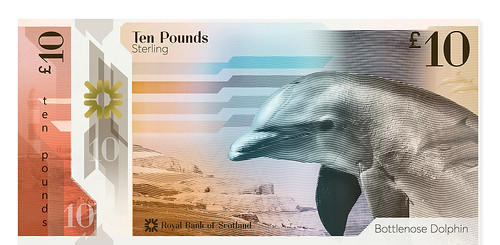
Just a few hundred of these playful, sociable, highly intelligent creatures remain in the Moray Firth and Cardigan Bay. If their international number is currently stable, there are fears that overfishing in the next couple of decades will leave bottlenose dolphins short of food.
What’s more, conservationists fear that toxic chemicals introduced to the sea by human culture may harm the general health of dolphins and their ability to reproduce.
To read the complete article, see:
UK Bank Notes Get A Makeover To Honor Endangered Species
(https://www.valuewalk.com/2018/12/uk-bank-notes-honor-endangered-species/)
News & Notes also led us to a withering critique from The Irish Times of the inclusion of Prime Minister Margaret Thatcher on the list of scientist nominees. -Editor
Thatcher graduated in chemistry from Oxford and spent some time working in food research, but her greatest contribution to science – and even this is disputed – looks to have been some minor tweaks to the recipe for Lyon’s soft-serve ice cream. You may as well nominate Adolf Hitler for an honour recognising “contribution to watercolour painting”.
To read the original article, see:
UK Banknote Concept Designs (Endangered Wildlife Edition)
(https://www.quickquid.co.uk/quid-corner/uk-banknote-concept-designs-endangered-wildlife-edition/)
To read the complete article, see:
Margaret Thatcher on the new £50 note? Time
for some Irish banknote nostalgia (https://www.irishtimes.com/culture/margaret-thatcher-on-the-new-50-note-time-for-some-irish-banknote-nostalgia-1.3713440)
To read the earlier E-Sylum article, see:
SCIENTISTS NOMINATED FOR NEW £50 NOTE (https://www.coinbooks.org/v21/esylum_v21n48a28.html)

LOOSE CHANGE: DECEMBER 9, 2018
Here are some additional items I came across in the media this week that may be of interest. -Editor
The National Banks of Brownsville, PA
Mark Hotz has a long-running column in Bank Note Reporter about National Banks. He travels to towns all across the country to visit and document the old bank buildings, many of which still stand today, usually adapted to some other purpose. His December 3, 2018 article records his visit to Brownsville, PA, a small town 40 miles south of Pittsburgh. Here are a couple paragraphs - see the complete article online for many images of notes and buildings. Great photo of an abandoned bank vault. -Editor

The downtown area is Market Street, which is reached off of US 40, which snakes around the town. During its heyday, it supported three large national banks. These were the Second National Bank, charter #2673, which succeeded the First National Bank when it was liquidated in 1882; the Monongahela National Bank, charter #648, which was chartered in 1864 and closed by the receiver in 1931; and the National Deposit Bank, charter #2457, chartered in 1880. These were all very large banks, with the two former issuing over $2,000,000 each in circulation, and the latter with $1.3 million. Though just one note is known from the First National Bank, large and small notes are known from the large three, though not as readily seen on the marketplace. T
Entering Brownsville on Market Street from US 40 is quite the experience. One is immediately amazed by the number of large and abandoned buildings lining both sides of the street. In the center of the downtown area is a large parking area where other large buildings once stood. I parked my car and wandered around the abandoned street. The Flatiron Building at the head of Market Street is owned by the Brownsville Area Revitalization Corporation (BARC) and was open. It has a lot of information about the town and many relics on display. It sits directly across Market Street from the abandoned Second National Bank building, which is part of a string of abandoned buildings culminating in the columned Monongahela National Bank building, also abandoned, which sits next to the parking lot.
To read the complete article, see:
A ghost town worth visiting
(https://www.numismaticnews.net/article/a-ghost-town-worth-visiting)
CDN Interviews Currency Dealer Lyn Knight
Josh McMorrow-Hernandez of CDN Publishing interviews paper currency dealer Lyn Knight in a video published December 5, 2018. -Editor
Lyn Knight of Lyn Knight Auctions is one of the most well-respected paper currency experts in the industry, having handled some of the rarest and most valuable notes around. His currency auctions cover a wide variety of issues and appeal to the wide spectrum of paper currency collectors.
When we caught up with him at the winter 2018 Baltimore Whitman Expo in late October, he was getting ready for a big currency auction. But he was kind enough to take a few moments with us as he talked about some of his favorite notes and how he got his start in the hobby many years ago.
As we recently learned in that interview with Knight, the paper currency dealer with more than five solid decades of experience hasn’t always dealt in greenbacks. In fact, he got his start in numismatics at the age of 13 in a way most of us who know Knight as a paper currency guy probably wouldn’t have expected. Let’s just say it didn’t involve rare paper currency, but rather the items you might buy to store it in.
To watch the complete video, see:
A Conversation With Paper Currency Expert Lyn Knight (http://blog.greysheet.com/lyn-knight-paper-currency/)


